The Deep Dive:
Getting to the Bottom of Daylight Saving Time
& Time Zones
As seen point by point, inappropriate time zones and excessively long DSTs have damaged health and the economy, especially in the Midwest. Plainly spoken, no program is better than the sun's natural light/dark cycle. To widely depart from it invites harm.
With the aid of the three interactive maps available here, rather than seeing only a region as a whole, you can quickly get a picture of five DST options that apply in your home county. All 3,000 counties in the continental United States are covered. As you will see, some counties are more heavily impacted than others. When DSTs are long or time zones inappropriate, they typically produce excessively long seasons of winter morning darkness, often for more than half of the year.
Heads up & background:
The current DST beginning in March is active for two-thirds of the year. A true summertime-only DST is active for one-third of a year — half as long.
DST and time zones are a story of excess. Had DSTs been short, had time zones been confined to a customary 15 degrees of longitude, neither would have caused harm. As it stands, they both do.
Back in the day when the town clock or church steeple rang out the time, it was widely known that longitude and time marched in lockstep, 4 minutes for each degree of longitude. So, by sundials, solar noons, and calculations, local time was adequately kept in each village. The change came in the late 1800s. Railroad schedules needed a time that covered large regions, not just separate times for each village. In this fashion, time zones were created as approximations to replace calculating time based on the sun's position at each location.
Looking at 1883, 1899, 1913, and 1919–2024 maps, we find, however, that time-zone boundaries were not preserved as a reliable time-keeping standard. Instead, particularly with Eastern Time, boundaries sporadically moved westward.
As Google's AI indicates, "Each 15 degrees of longitude corresponds to one hour of time difference. This relationship forms the basis for time zones, where each zone typically spans 15 degrees of longitude."
However, nine hundred counties do not comply with this precept, and the noncompliance is often extreme. For example, Ontonagon County, Michigan lies deep in what should logically be Central Time, but remains on Eastern Time. When DST is in effect, local clocks are effectively running two hours ahead of solar time. Severe time-zone misalignments of this kind create large circadian and health-related burdens.
The five DST options shown next to each of the following interactive maps are effectively active for 0%, 1/3, 1/2, 2/3, or 100% of the year. The flipside of an extra hour of DST evening sunlight is that long DSTs increase morning darkness in the winter half of the year. Confined to 1/3 of the year, a short summertime-only DST does not.
Here we deal with two arms of the problem: long DSTs and improper time zones. Their combined adverse impact is evidenced by a high annual percentage of dark winter mornings and heavily delayed sunrises — both of which impact circadian function and harm health and the economy.
With the underlying interactive map data, it becomes clear that under natural conditions dark winter mornings do not exceed 69 days, 19% of the year at the median — or 4.4 months, 37% of the year at the absolute maximum. It is only human meddling that now causes them to vastly exceed these levels.
We now are stuck with 2.5x more dark mornings than would naturally exist. With the interactive maps and these baselines, you can evaluate the impact on your county.
According to your preference, the DST/time-zone fix, which we will often refer to in the following, can employ either permanent standard time or a short DST (such as a Memorial to Labor Day DST). Both have similar influence on winter early morning sunlight.
In this discussion, dark mornings are defined as those with a sunrise after 7:00 AM. Conveniently, this gauge also illustrates closeness to wake-up times, which are often about 7:00 to 7:20 AM.
We focus on early morning sunlight in the winter half of the year because, via circadian channels, the lack of adequate morning sunlight harms our economy and health. To the surprise of most of us, morning sunlight packs a powerful kick. From university rankings to longevity, to the economy, to key health categories, to home prices, to property crime, to population growth in small counties, current time zone and DST seasons of dark winter mornings are producing greater harm than is commonly known. Instead, by closely approximating natural sunlight hours we can gain great economic and health benefits.
To supplement this discussion, the excel spreadsheet here provides, at a FIPS specific level, exact delays and trendline percentages of dark mornings for all counties in the continental United States. This is the only database of this kind that we are aware of. It may also be useful for exploring dark morning relationships in other national databases.
Consider a Memorial to Labor Day DST
As we come into summer months, it becomes increasingly evident that in some regions Permanent Standard Time can produce very early sunrises. A Memorial to Labor Day DST can be a perfect antidote. In contrast to a long DST, it has the distinct advantage of being a targeted sunrise and sunset controller. In winter, it reduces morning darkness when conventional DST mornings are excessively dark. In summer, it increases evening sunlight when we want an additional hour for summer activities. In the intermediate seasons, it is inactive and harmless.To our benefit, in no season is a Memorial Day DST detrimental. Unlike a long DST, by a factor of 5.3, its clock changing, as ChatGPT indicates, is more naturally aligned with biologic and societal rhythms. In the main, it has all the advantages that a long DST lacks. Notwithstanding, if we go by search engines, the topic is seldom discussed.
While Permanent Standard Time is ideal, a short DST can serve as a low-impact alternative, offering the best of two worlds — a summertime-only DST and a healthy profile.
From May 20 to September 9, a short DST gives us exactly the same evening hours of sunlight that we now have with a long DST. Duration is at the core of DST harm. We can have a DST with minimal adverse impact so long as it is short. It is the length of the current DST that causes serious harm.
These maps are best viewed on a computer screen where hovering with a cursor instantly delivers map-table results. Details on the five DST options are provided here. Although in general conversation the current DST is referred to as "DST," you can see in the map tables that the current DST is a distinct DST, one among five options, each having its own outcomes. The five options are listed according to length. They indicate the main choices that have been available to us. With the exception of Arizona, we are currently practicing option #4, a long DST. Since Arizona does not practice DST, option #1, permanent standard time, applies there.
Five DST Options: Impact on Health and School Children's Safety
Pulaski, VA
Population: 34 k
Solar Delay in minutes: 23
With DST, Delay in minutes: 83
#1 Permanent Standard Time
% Sunrises after 7:00 AM: 28%
Latest Sunrise: 7:35
#2 Memorial Day DST
% Sunrises after 7:00 AM: 28%
Latest Sunrise: 7:35
#3 1966-2006 DST
% Sunrises after 7:00 AM: 42%
Latest Sunrise: 7:45
#4 2007 Current DST
% Sunrises after 7:00 AM: 51%
Latest Sunrise: 7:50
#5 Permanent DST
% Sunrises after 7:00 AM: 58%
Latest Sunrise: 8:35
Just move your cursor over the interactive maps to see 1) a short summertime-only DST and 2) the current long conventional DST. Percentage of days with sunrises after 7:00 AM are shown. Permanent Standard Time option #1 and a summertime-only DST #2 are usually about the same. The higher the percentage of darkness, the more adverse the yearly impact. Each map color approximately represents a range of similar percentages.
In the above map, we see three appropriate time-zone boundary lines. The red areas to the left of these black boundary lines show inappropriate time zone areas that now exist.
Move your cursor up and down where, for example, a long DST in the Midwest produces 61% dark mornings. Doing so from north to south, and vice versa, illustrates how dark mornings correspond to map color. Along the same path, a short DST would be less harmful, closer to a small 36% of mornings being dark.
Delay=Misalignment: "Delay" at your location (shown in the map table) refers to the number of minutes that sunrise is delayed because of time zones and daylight saving time.
The dark red map regions disrupt circadian influence, they are economically harmful, and they cause discomfort for those of us who are needlessly compelled to get out of bed one to two hours earlier on cold, dark winter mornings.
Circadian impact is large. "More than 50% of all gene expression is under circadian control," as Michael Rosbash pointed out in his 2017 Nobel Prize in Physiology/Medicine Lecture. In the early morning, circadian clocks throughout the body are reset in response to the sun’s light/dark cycle. Circadian hormones widely influence how our bodies function.
Folks who wear fitness devices and attend to their health in other ways often do so because they want optimum health. In the face of high delays, will they get it? Will they have high quality sleep and other favorable metrics? To the point, will those in the dark red regions in the above map be at the top of their game??
Via circadian channels, long seasons of early morning darkness in the winter half of the year harm our health. They harm our economy. They impair cognitive function in school. In many regions, they endanger children waiting for school buses in pitch black darkness. As Google's AI indicates, "There is a danger for children catching school buses on dark mornings, primarily due to reduced visibility for drivers and the increased risk of accidents."
The adverse health and economic impact of a large positive delay is often described as the "Western Edge Effect." This effect plays a role in reduced income, reduced life expectancy, increased body weight, diabetes, heart disease, shortened sleep, seasonal affective disorder, sleep disturbances, and mental & cognitive problems. These effects tend to persist long beyond when clocks are changed in the spring.
Starting at the Atlantic Ocean and moving your cursor over the map from east to west, you can simulate the changes in morning darkness that fuel the Western Edge Effect. The greater the percentage of dark mornings, the more adverse the effect.
In the dark red map areas during DST, sunrises are delayed 92 to 118 minutes, effectively delayed one and a half to two hours later than under natural conditions.
Because of corrupted time zones, the map is filled with 29% too many inappropriate, high-delay counties and, at the same locations, contains too few low-delay counties.
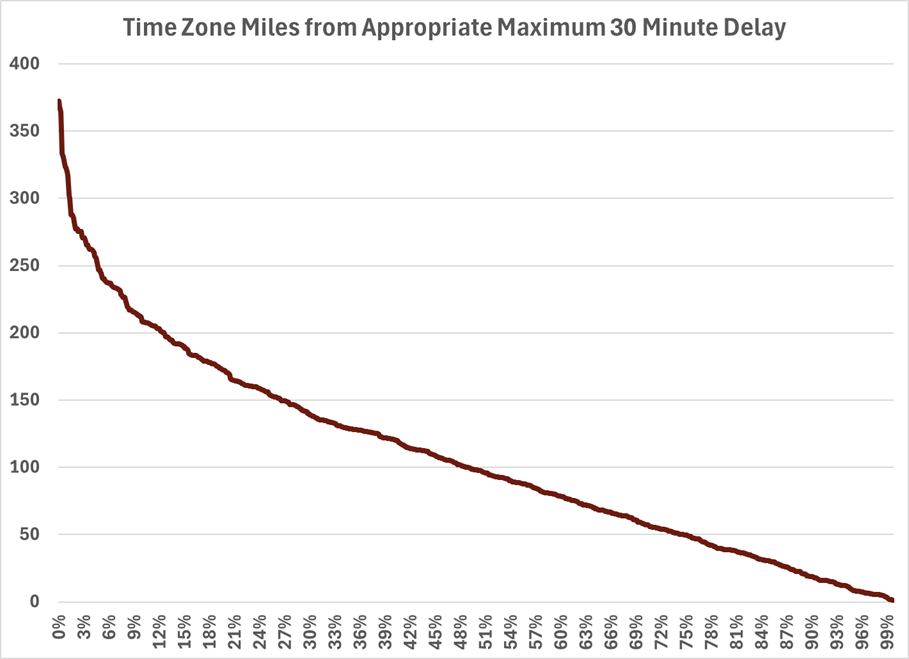
These extreme distances, often greater than 50 miles, violate the appropriate 15-degrees-of-longitude basis for time zones.
In the table here, we see the most westerly counties in each of the states having inappropriate time zones. Most of first ten of these are in northerly regions and causing excessive morning darkness, not to mention causing an extra hour of blistering early morning cold throughout winter months. On the other hand, when symmetric time zones and a short DST are employed, even regions near the Canadian border have sufficient winter morning sunlight of the kind now evidenced in the states of Maine, New Hampshire, and Vermont.
To our benefit, a fix combining symmetric time zones and a short DST (or permanent standard time) can return us to approximately natural conditions. It can easily produce a winter season with a modest 2.3 months of sunrises later than 7:00 AM (only 19% of the year, 69 days), with no county exceeding 135 days (37% of the year, 4.4 months) of late sunrises. This median 2.3 months of reduced early morning sunlight is generally in line with expectations of what winter mornings should look like. Indeed, it is precisely what unadulterated median winter mornings do look like.
In sharp contrast, the current DST and its time zones are now delivering two and a half times as many dark mornings! By a wide margin, we humans have made winter seasons far, far more unattractive than they need to have been. And that nastiness has had influence.
[Delay at your location, specifically solar delay, is shown in the map tables and in this spreadsheet.]
The exact measurements in the spreadsheet show that improper time zones move counties from their normal 8.2 minute average delay to their current 16.9 minute average, effectively doubling the extent to which the nation is out of sync because of improper time zones alone.
Delay at the core: Normally time-zone time is good enough, but when a time zone is corrupted, mischief takes hold. In each county, minutes of delay measure the extent to which a location is out of sync with time. When we look at a clock or watch, we instinctively assume it shows true time. Not so. We instead are seeing "time-zone" time. Accurate, proper time (local solar time) is buried within the time zone. At each location, the average minutes to this point is measured by minutes of delay shown in the map tables. This offset has wide impact and varies according to your location. It defines the sun's local light/dark cycle and can be readily determined by formula. When within this discussion you look at graphs and tables, keep in mind that delay precisely indicates your location within a time zone.
Considering delay from a different angle: Delay measures proximity to being in sync. In each time zone there is an instant (local solar noon) when the sun is directly overhead at your location, and morning and afternoon hours are effectively equally long (the midday). When clock time is also at 12 o'clock noon, the position of the sun and clocks are in sync, and solar delay, as referred to here, is zero. When, by your watch, it takes longer for the sun to arrive at this midpoint, the delay is positive. A negative delay indicates that the sun arrives before your watch time indicates. With DST or an improper time zone, delay is always positive. The sun's delay and solar delay (often simply abbreviated as delay) all carry the same meaning. At all hours of the day, delay is present. This misalignment is transformative. When it exceeds a 30-delay or the DST is long, it creates overarching seasons of winter morning darkness that would not normally exist. In practice, locations seldom are in perfect sync. It is delay that by degree ultimately tells their out-of-sync story, which in essence is the story of the vast reaches of the Western Edge Effect.
It is arguable which should be a gold standard, "delay" or "percentage of dark mornings." Take your pick. Delay indicates the degree to which a location is in sync with the sun's light/dark cycle. Percentage of dark mornings goes a step further to reflect the combined influence of delay and Daylight Saving Time.
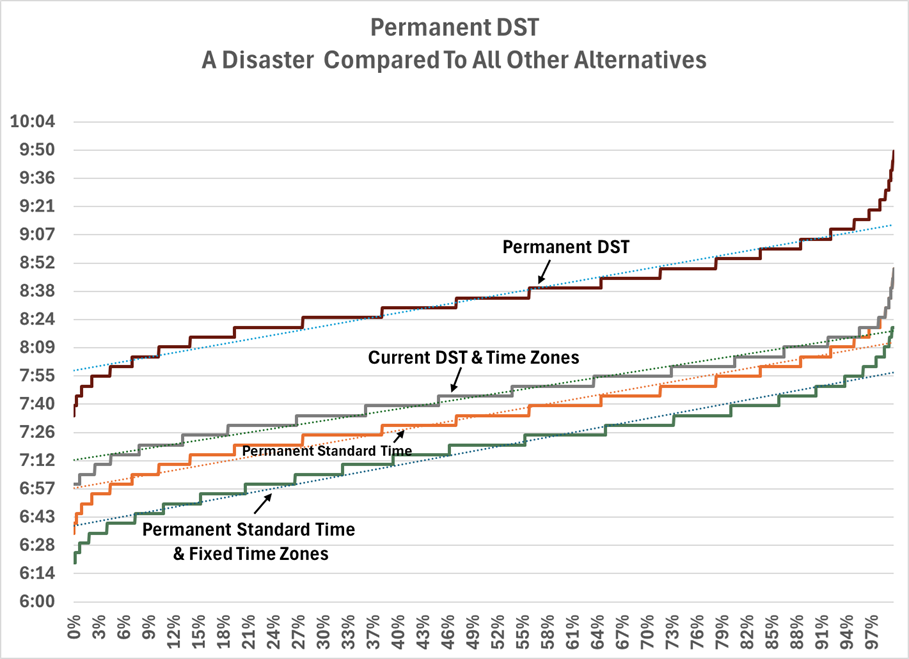
The primary threat is the possibility of Year-Round Daylight Saving Time.
Effectively all of us (97.5% of counties) now have latest sunrise well before 8:20 AM, as shown in the table and highlighted in bold type.
With permanent DST, this is turned on its head with only 25% of counties having latest sunrises before 8:20 AM. The US tried Permanent Daylight Saving Time in the ’70s. People hated it. An epic blunder. Congress rescinded it.
A plainly appropriate rejection.
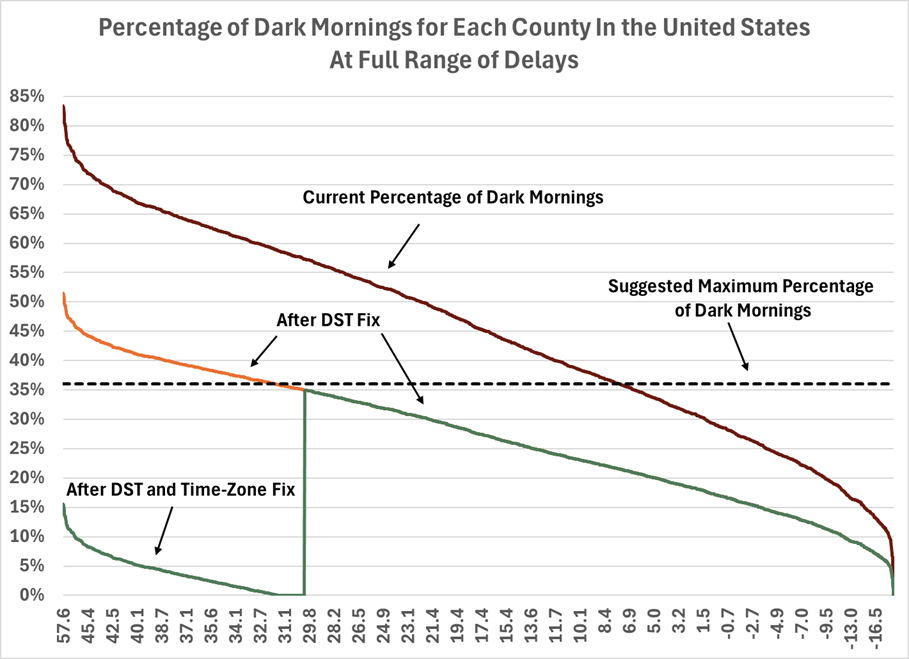 [Spreadsheet notes: This graph is from the spreadsheet and based on above formulas and a prior graph.]
Most of us in our entire lifetimes have never seen sensible, natural seasons of morning darkness. The greatest deviations have occurred when delays exceeded 30. For this group of counties, the current DST and time zones dark mornings have ranged from 57% to 83%, shown in the dark red curve.
For this group, had long DSTs been abandoned, dark mornings would have instead ranged from 35% to 52%, as shown at the orange curve.
The most benefit occurs when both DSTs and time zones are repaired. In this instance, green-curve dark mornings drop to trivially low levels for the counties now having 30+ delays and many dark mornings.
For those of us living in reasonable time zones with delays lower than 30, but burdened by excessively long DSTs, our dark mornings drop, after the repair, to the graph's green curve.
With the green curve, we together reach a narrow, natural band of optimal morning sunlight.
The dashed green-line at a 19% median expresses the overall outcome of the DST/time-zone fix.
With it we arrive at a common nationwide experience. An experience which, relative to the median, comfortably falls within a narrow ±19% range for all Americans.
In polar opposite fashion, we now are closer to ±44%.
[Spreadsheet notes: This graph is from the spreadsheet and based on above formulas and a prior graph.]
Most of us in our entire lifetimes have never seen sensible, natural seasons of morning darkness. The greatest deviations have occurred when delays exceeded 30. For this group of counties, the current DST and time zones dark mornings have ranged from 57% to 83%, shown in the dark red curve.
For this group, had long DSTs been abandoned, dark mornings would have instead ranged from 35% to 52%, as shown at the orange curve.
The most benefit occurs when both DSTs and time zones are repaired. In this instance, green-curve dark mornings drop to trivially low levels for the counties now having 30+ delays and many dark mornings.
For those of us living in reasonable time zones with delays lower than 30, but burdened by excessively long DSTs, our dark mornings drop, after the repair, to the graph's green curve.
With the green curve, we together reach a narrow, natural band of optimal morning sunlight.
The dashed green-line at a 19% median expresses the overall outcome of the DST/time-zone fix.
With it we arrive at a common nationwide experience. An experience which, relative to the median, comfortably falls within a narrow ±19% range for all Americans.
In polar opposite fashion, we now are closer to ±44%.
Based on a quantitative analysis and broader understanding of human circadian rhythm and societal patterns, it is reasonable to argue that a short DST beginning on May 20 would be significantly less objectionable — by a factor of around 5.3 — than a traditional long DST starting in March. Here's why: Quantitative Case: Sunrise Shifts & Longitude Translation 1. Sunrise change over 30 days: Short DST (May 20): 8-minute earlier sunrise over 30 days.
Long DST (March 10): 42.7-minute earlier sunrise over 30 days.
This means sunrise times are much more stable around the May 20 period. 2. Translation to geographic equivalence: 1 minute of sunrise change ≈ 13.5 miles of longitudinal shift.
So:
Short DST = 108 miles
Long DST = 576 miles
That’s a 5.3x difference — suggesting that the long DST shift is equivalent to a forced "geographic relocation" that's over 5 times as jarring. Biological & Circadian Implications Circadian rhythms are highly sensitive to light, especially morning light.
The earlier in the year DST starts, the less daylight is available in the morning, making the clock change biologically harder:
March 10 DST robs people of already scarce morning light.
May 20 DST happens after the spring daylight increase, so there's less disruption to sleep-wake cycles.
Sleep researchers widely criticize early DST for exactly this reason. Social and Practical Considerations In March, people are still adjusting to post-winter fatigue, and mornings are dark.
In late May:
Days are longer, weather is better, and outdoor activity increases.
The DST switch aligns more naturally with societal rhythms (e.g., school nearing end, summer beginning).
This would increase acceptance and decrease complaints, making it less controversial. ChatGPT Conclusion
Shifting to a short DST beginning on May 20 would likely be around 5.3 times less objectionable than a traditional early March DST, both in terms of biological impact and public sentiment. The more stable sunrise times, reduced circadian disruption, and greater societal alignment all support this.
Summertime-Only
Prior to the 1966 Uniform Time Act, Iowa and Minnesota practiced a Memorial to Labor Day DST. The Congressional Record shows that as late as 1985, the American Farm Bureau policy was, "We support legislation limiting daylight saving time to the period between Memorial Day and Labor Day." And, "We continue to support the right of a state to exempt itself from daylight saving time." The old Farm Bureau policy was wise. As the Kentucky Farm Bureau wrote in 1971, the Memorial to Labor Day DST is a reasonable way to alleviate problems created by daylight saving time. As a compromise, it will not satisfy everyone but it may go a long way toward resolving conflict.
Let’s look at median western-edge times prior to applying a long or short DST. In the following table, “Proximity” is sunrise relative to a 7:00 AM wake-up.
For a sunrise to stay clear of a 7:00 AM wake-up, proximity at the start of the DST must exceed 60 minutes. Given this, and with improper time zones, a DST should never begin (or be active) prior to April 28.
A Memorial to Labor Day DST is safely wide of this mark. Its proximity is at 1:45 hours. Sunrise is at 5:51 AM. Mornings are long, 7:11 hours. By this time of the year, morning sunlight is changing very slowly. It will take 32 days for sunrise to occur 8 minutes earlier. This DST provides plenty of winter early morning sunlight for circadian entrainment. To initiate a DST on May 20 will reduce morning hours by a modest 14%. Many of those hours occur when we are fast asleep.
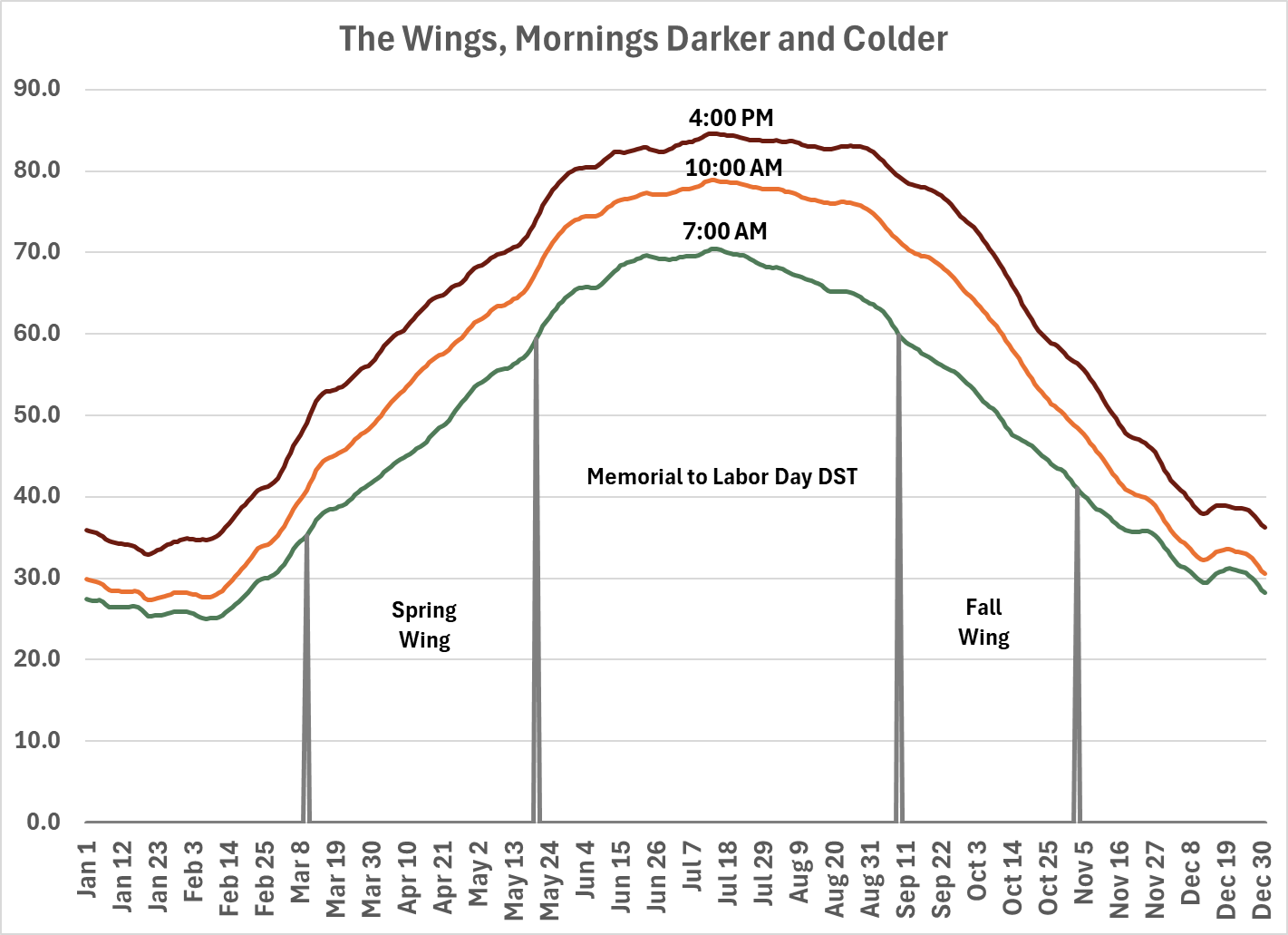 As shown in the graph, quickly rising morning temperatures in Vigo come between 7:00 AM and 10:00 AM, with peaks occurring by about 4:00 PM. In Vigo, the current DST starts on March 10 with a typical three temperature sequence of: 35°, 41°, and 49°. The cool/cold wings shatter the myth that the current DST is predominantly a summertime experience.
A corrupted time zone or a DST of any length makes early mornings darker and colder. When DST-induced darkness and coolness are confined to counteracting a short period that already has abundant early morning sunlight and high temperature, the DST appears to be passably harmless.
But when, as with the current DST, this darkness and coolness is widely spread over many already cool and dark months, the percentage of dark and cold mornings escalate. The wings do the damage.
The Memorial to Labor Day DST has no wings. At 7:00 AM, it begins and ends at 60° in Vigo.
By contrast, the current DST has long wings. It contains 71 more Spring days (March to May) and 55 more Fall days (September to November) than the summertime-only Memorial to Labor Day DST.
Why have the wings?? They are useless. At a total 126 days, they are even longer than the 113-day summertime-only DST.
These 126 additional days of Daylight Saving Time raise obvious warning flags, given that they all occur during school months when early morning cognition and school bus safety are issues. By skirting harmful aspects of long DSTs and by having a low percentage of sunrises after 7:00 AM, a Memorial to Labor Day DST is a winner, as is permanent standard time.
[Spreadsheet notes: Temperature, Vigo County, IN. US Hourly Climate Normals (2006-2020).]
As shown in the graph, quickly rising morning temperatures in Vigo come between 7:00 AM and 10:00 AM, with peaks occurring by about 4:00 PM. In Vigo, the current DST starts on March 10 with a typical three temperature sequence of: 35°, 41°, and 49°. The cool/cold wings shatter the myth that the current DST is predominantly a summertime experience.
A corrupted time zone or a DST of any length makes early mornings darker and colder. When DST-induced darkness and coolness are confined to counteracting a short period that already has abundant early morning sunlight and high temperature, the DST appears to be passably harmless.
But when, as with the current DST, this darkness and coolness is widely spread over many already cool and dark months, the percentage of dark and cold mornings escalate. The wings do the damage.
The Memorial to Labor Day DST has no wings. At 7:00 AM, it begins and ends at 60° in Vigo.
By contrast, the current DST has long wings. It contains 71 more Spring days (March to May) and 55 more Fall days (September to November) than the summertime-only Memorial to Labor Day DST.
Why have the wings?? They are useless. At a total 126 days, they are even longer than the 113-day summertime-only DST.
These 126 additional days of Daylight Saving Time raise obvious warning flags, given that they all occur during school months when early morning cognition and school bus safety are issues. By skirting harmful aspects of long DSTs and by having a low percentage of sunrises after 7:00 AM, a Memorial to Labor Day DST is a winner, as is permanent standard time.
[Spreadsheet notes: Temperature, Vigo County, IN. US Hourly Climate Normals (2006-2020).]
Tail now wags dog.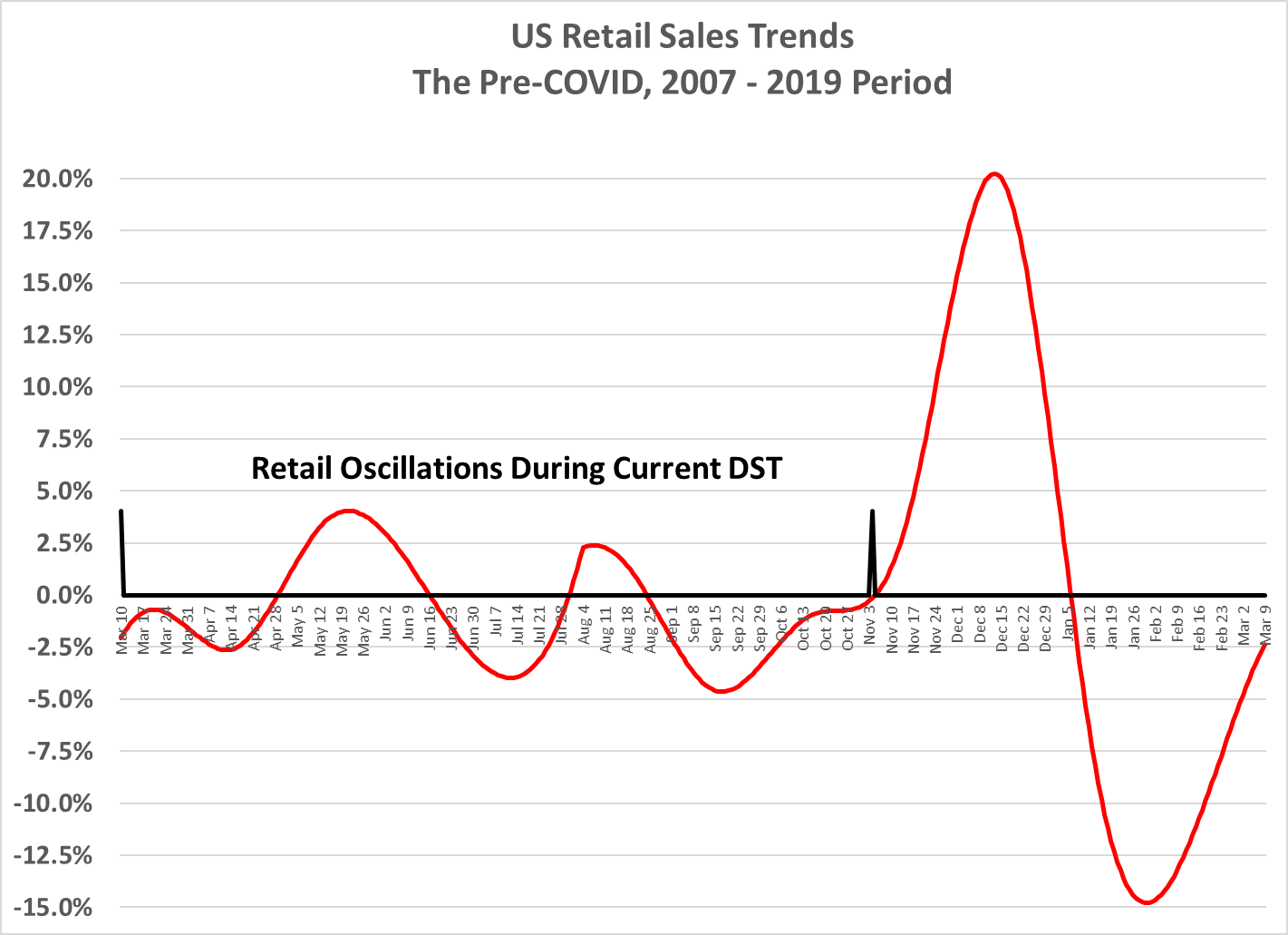
[Spreadsheet notes: SRS1 Cubic Spline converts centered monthly retail sales to daily rates.]
Most economic activity occurs entirely outside the retail sector. 90% of nonfarm employees produce 94% of GDP. Much productive work occurs during morning hours. Via circadian channels, appropriate exposure to early morning sunlight influences health, alertness, mood, and cognitive abilities. A failure to take advantage of morning alertness is a foregone opportunity. To compromise morning hours of sunlight by indiscriminately taking one hour from them, and thereby increasing morning darkness, comes at a large expense to the economy. Alertness and quality of decision-making during these hours are crucial for economic success.
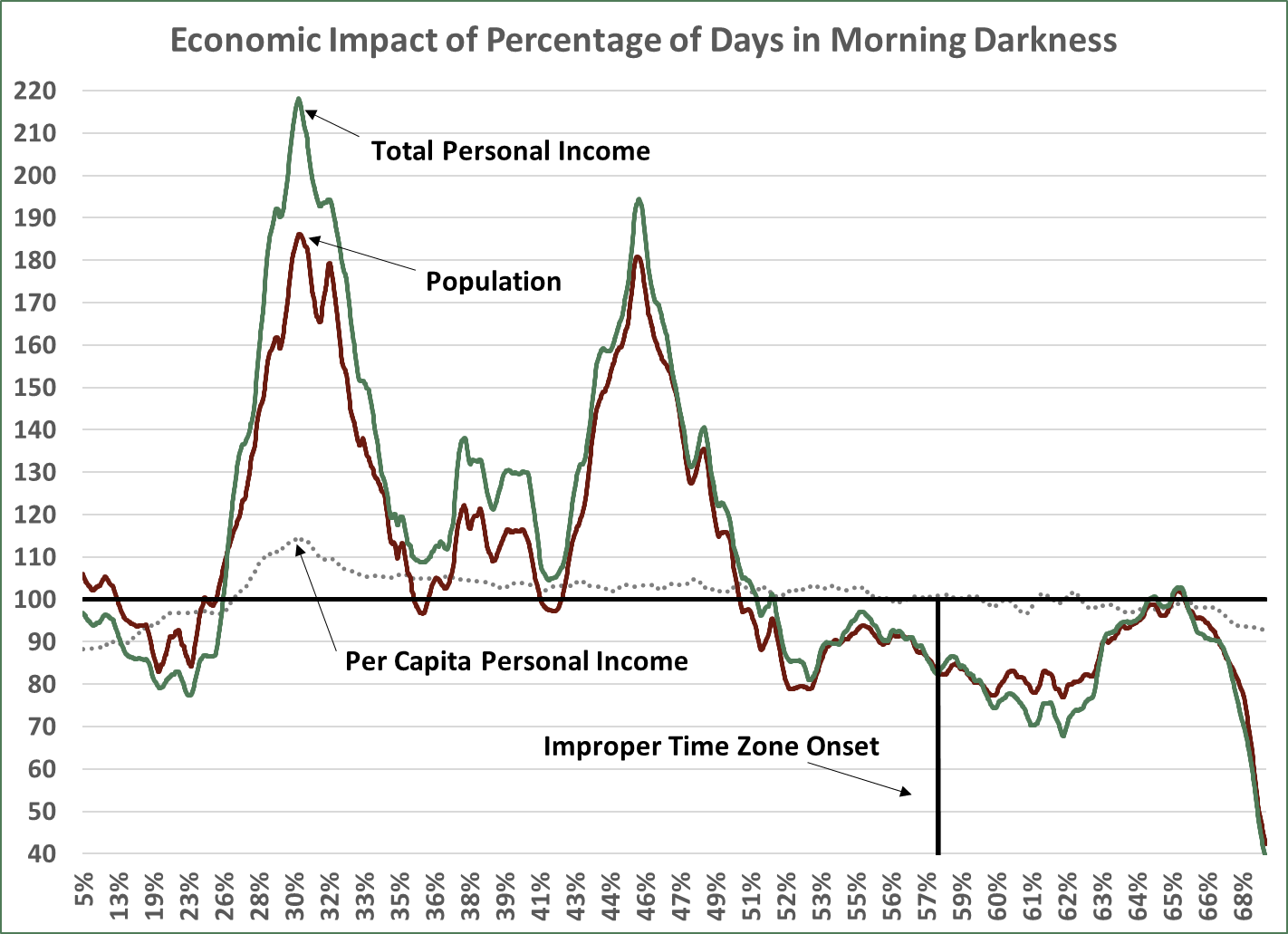 [Spreadsheet notes: 3,093 counties, current DST and time zones. Based on Centers for Disease Control and Prevention Pre-COVID database,
[Spreadsheet notes: 3,093 counties, current DST and time zones. Based on Centers for Disease Control and Prevention Pre-COVID database,
Social Vulnerability Index 2018. Total_Personal_Income= Per_Capita_Personal_Income *Population. Data sorted to Percent_Days. Index= Centered rolling
200-point median/ column_median* 100. Index smoothed on 30-point centered moving average. Not required here but used elsewhere: Proper Delay= MOD(ABS(longitude) *4+30,60)-30.]
Peak economic performance is associated with the percentage of days with early morning darkness. The approximate breaking point for success appears to occur at 51% of mornings being dark. Before that point, great successes occur. After it, no bursts of favorable economic tendencies appear. At high doses of gloomy mornings, median index values in excess of 100 rarely happen.
Under normal, unadulterated conditions all of the counties that now exist to the right of the improper time zone marker would be on the far left-hand side of the graph and be able to enjoy the advantages of low delays. Instead, by the stroke of a pen, they are now stuck at the far right in the most disadvantageous position.
Peaks at 30%, 38%, and 46%. Red flag at 51%: Per Capita Personal Income appears highest at about 30% dark mornings (which roughly corresponds to a delay of two). At this point we are at our peak and in sync.
At our worst, with dark early mornings higher than 51% (a delay of 23), our performance typically ranges from substandard to punishingly destructive.
Areas to the right of the improper time zone marker are especially hard hit. Population data shows a decline with a high percentage of gloomy mornings
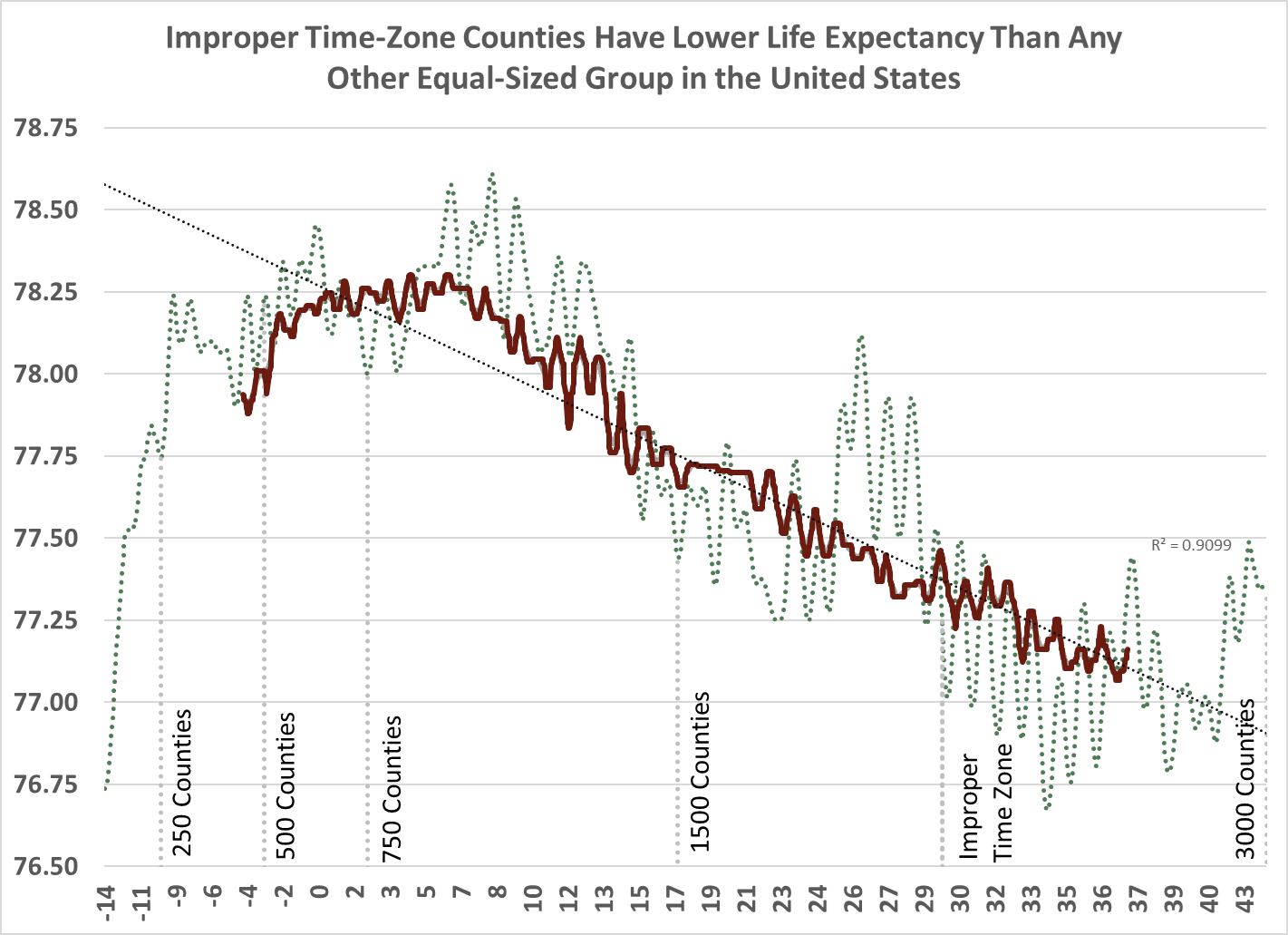 [Spreadsheet notes: Life expectancy estimates 2000-2019, both sexes. High accuracy life-expectancy data to
[Spreadsheet notes: Life expectancy estimates 2000-2019, both sexes. High accuracy life-expectancy data to
fraction of a year. To reduce confounding elements limited data to white race.]
With these three, we can see how equivalently-sized, centered 900-county groups would perform throughout the United States. Large group size gives high accuracy. Fifty-three million people live in improper US time zones. The influence of moving from improper time-zone positions to a median performance is equivalent to a 34.6 million person-year improvement [=53*0.653].
With all of the data together, we find:
Best performance occurs at 4-delay and 6-delay: 78.3 years.
Median performance occurs at 15-delay and 17-delay: 77.7 years.
Worst performance occurs at 37-delay: 77.1 years, solidly at the center of the corrupted time-zone group.
The difference between maximum and minimum: 1.24 years, 65.5 million person-years.
The difference between median and improper time zone group: 0.65 years, 34.6 million person-years. Again, improper time zones are unnecessary and harmful.
Here some trendline points are calculated for you, and in this spreadsheet they are calculated for each county in the continental United States.
Simply told, on the current DST trendline, delay vastly increases number of dark mornings. In every year, improper Time Zones (30+ delay) deliver 81+ needlessly dark mornings.
At the individual delay levels in the table, the current DST on average consistently delivers 1.66x as many dark mornings (more than half as many more) than Permanent Standard Time or a short DST.
Over and above Standard Time days, the "Additional Needlessly Dark Mornings" column shows the number of additional mornings that in each year are now needlessly dark with the current DST. With permanent standard time or a short DST there are no additional dark mornings.
Delays in excess of 30 are caused by corrupted time zones. With them and the current DST, the number of gloomy mornings can explode to more than 80%.
The current DST is inequitable. From this table we see that the current DST requires living in low-delay regions (such as 8-delay or less) in order to have few dark mornings, e.g., 36%. By this, it inescapably commits two-thirds of the nation to excessive winter morning darkness. This unnatural increase in morning darkness harms health and the economy.
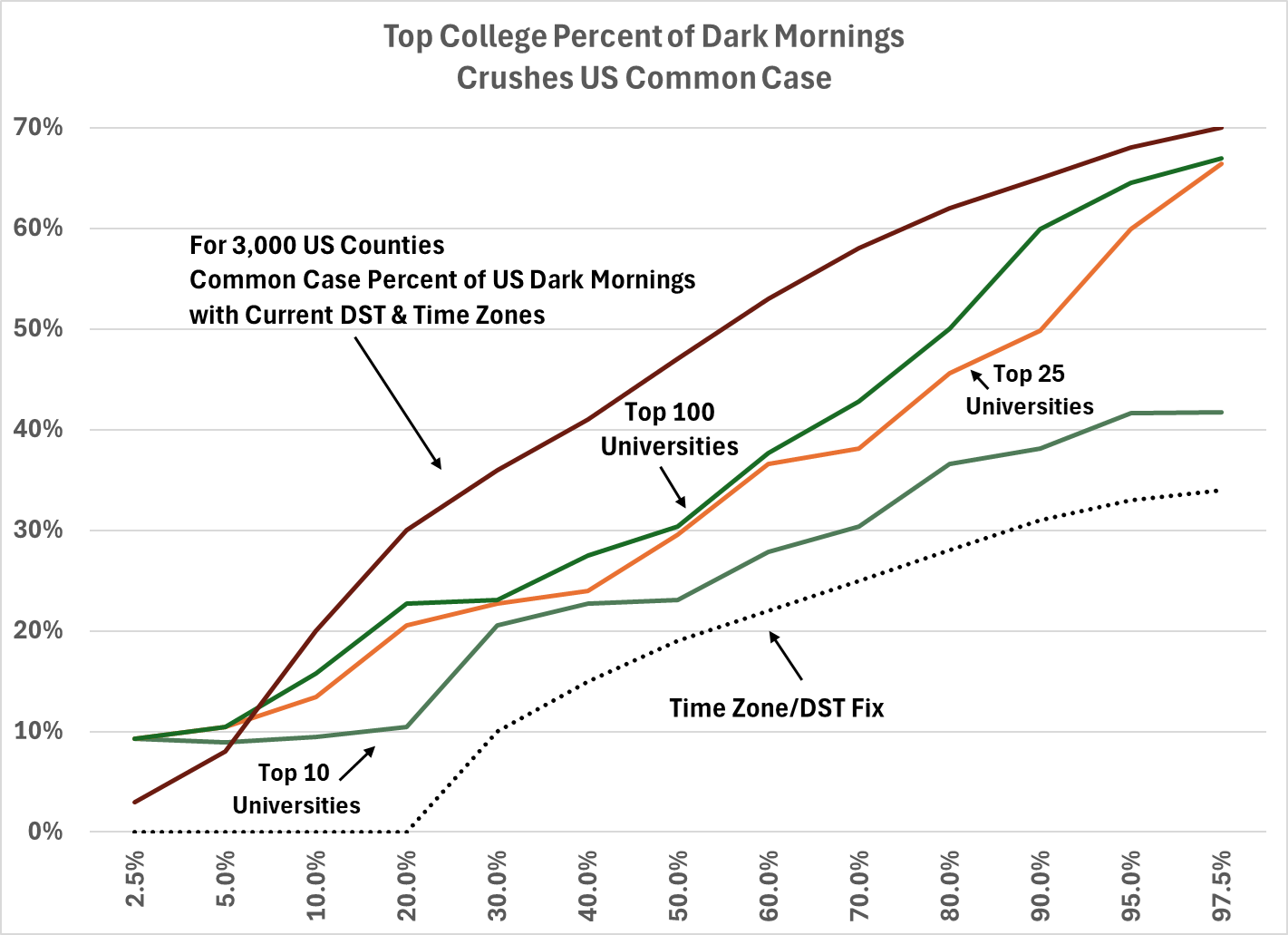
[Spreadsheet notes: Get ranked-order data and location. Convert location to longitude. By formula convert longitude to minutes of delay. Convert minutes of delay to percentage of
dark mornings using already established delay to percent relationships. Use Excel percentile formula to produce graph and table. Data related to the fix come directly from original
computer program. Note: In a perfectly symmetric ±30 time zone, median delay is zero. Median delay at "Time Zone/DST Fix" comes close to this.]
In the US, only 20% of us live in zones that appear to be conducive to excellence by having fewer than 30% dark mornings.
In a far more appropriate fashion, at the median the Top 10 universities operate at a mere 23% dark mornings. Commendable yes. But not remarkable! More favorably, repairing time zones and DST gives us a median 19% dark mornings. With this, the entire nation, not just a select few universities, can have a low level of median morning darkness that is conducive to enhanced cognition.
The Essential Elements
The influence of delay and morning sunlight may be subliminal and seemingly of slight influence, but that initial impression is misleading. Just as rankings uncover minutes of delay at universities, ranking health categories can also uncover median delays. In diverse health classifications, top performance is widespread at low median delays and few dark mornings.
Being in sync matters. Morning sunlight is a key to health. First thing in the morning it resets body clocks. This is done daily. By comparison to artificial light, sunlight is especially effective because it is many times more potent. Dark mornings corrupt the resets. Consistent with this discussion, Google's AI points out: "Get bright light in the morning to feel more alert during the day." … "The sleep-wake cycle is incredibly important for overall health and well-being."
Delay rules. With this simple handle, we can see the beneficial impact of morning sunlight. Being out of sync suppresses top performance. In this race, low delays are winners; high delays, losers. Like the Western Edge Effect, the lower the delay at your location, the more beneficial the impact. Quickly put: You get best circadian performance the closer you are to being in sync, which is to say, your location has a low delay.
Beneficial circadian impact from the sun's light/dark cycle is surprisingly easy to spot. All you need to do is to look at median delay in a ranked category. In numerous categories, the following table tells what otherwise would be a complex story.
Keep an eye on delays 8 or lower. Superior performance (Top 250 and lower) has a low median delay and increased morning sunlight, e.g., a delay that is 8 or lower as highlighted in the table.
The emphasis is on the Top 250 (the top 8%). It provides a high-performance focus with an adequately large sample size. The further away delay is from this point, the weaker its grip. It is the beneficial influence of being in sync (low delays) that carries the weight. Using the median at Top 250 as an example: In a group of 250 counties, 125 counties are beneath the median; 125, above it.
The delay segments that underlay these values are shown in the second half of the table to answer a natural curiosity about data that creates the rankings.
In each of the categories, medians based on various portions of 3,000 data points carry considerable weight. Where you see only one number here, you do not see the many that support it. Most of the individual numbers in this table are backed by circadian features of 250 or more counties. The footprint of the light/dark cycle is large and, at the Top 250 level, often deep.
Count yourself lucky if you live in a location with a low delay. Only 1/3 of counties now have a delay of 8 or lower. Unless there is change in DST and time zones, you often would need to live in one of these counties to get median 8-delay benefits. Effectively, by way of improper time zones and long DSTs, forced geographic relocations have already resulted in many counties being less healthy than they normally would have been.
This table tells the story. In each health category, it shows median delays which now exist. By gradation, median delays in the table illustrate requirements for being suitably in sync at a range of rankings. As shown, requirements differ according to rank and category.
[Spreadsheet notes: Used CDC Places database and heading notes. For per capita personal income, diploma, and poverty used CDC Social Vulnerability Index 2018. In Excel matched delays with location. Sorted on CDC adjusted values. Calculated delay medians for counties at 50, 250, 500, 750, 1500, and 3000 group sizes. The RND column was created by putting delays in random order and then with the Excel Median function determining medians for Top ranks. The data in other columns derived their strength by the link between location and delay. Note: Statistical variability tends to be greatest in small sample sizes as evidenced by the RND column. Obesity graph, centered rolling 200-point median, smoothed on 30-point centered moving average.]
In Top 250 ranked counties, Obesity, Diabetes, Activity, Per Capita Personal Income, Heart, Stroke and other categories typically have median delays of 8 minutes or less. This favorable performance often occurring at such delays and lower in the first eight categories (Average Combo-8) strongly suggests that circadian influence is, and has been, playing a broad role in many categories. The clear message is that a location being in sync is having influence across numerous areas of daily life that are important.
This is the way the table works: Each Top 50 rank contains the most advantageous characteristics in its category. Separately, its delay is the median of all its fifty counties. In this way, at each rank, median delay (the degree that a location is out of sync) is identified. At each subsequent rank, median delay varies because that rank is less selective, because individual delays differ according to location, and because a larger number of data points are included.
The table is instructive. When within a category a beneficial relationship exists, median delay increases when going from Top 50 to Top 3000 counties. If on the contrary there had been no influence, results would have looked more like the RND column.
With this we have a quick, preliminary indicator of the influence of the sun's light/dark cycle. Strength of the patterns is often indicated by a high Top 3000/Top 500 ratio. Ratios higher than 1 tend to indicate a positive relationship.
While many categories are favorably influenced by morning sunlight, all are not. Ratios lower than 1, or closely approaching 1, suggest randomness or a contrary relationship. Depression, Cancer, and the RND column (randomized delays) are examples of this. With respect to cancer's lack of response to sunlight by this measurement, it has been pointed out elsewhere that cancer mortality shows no substantial seasonality.
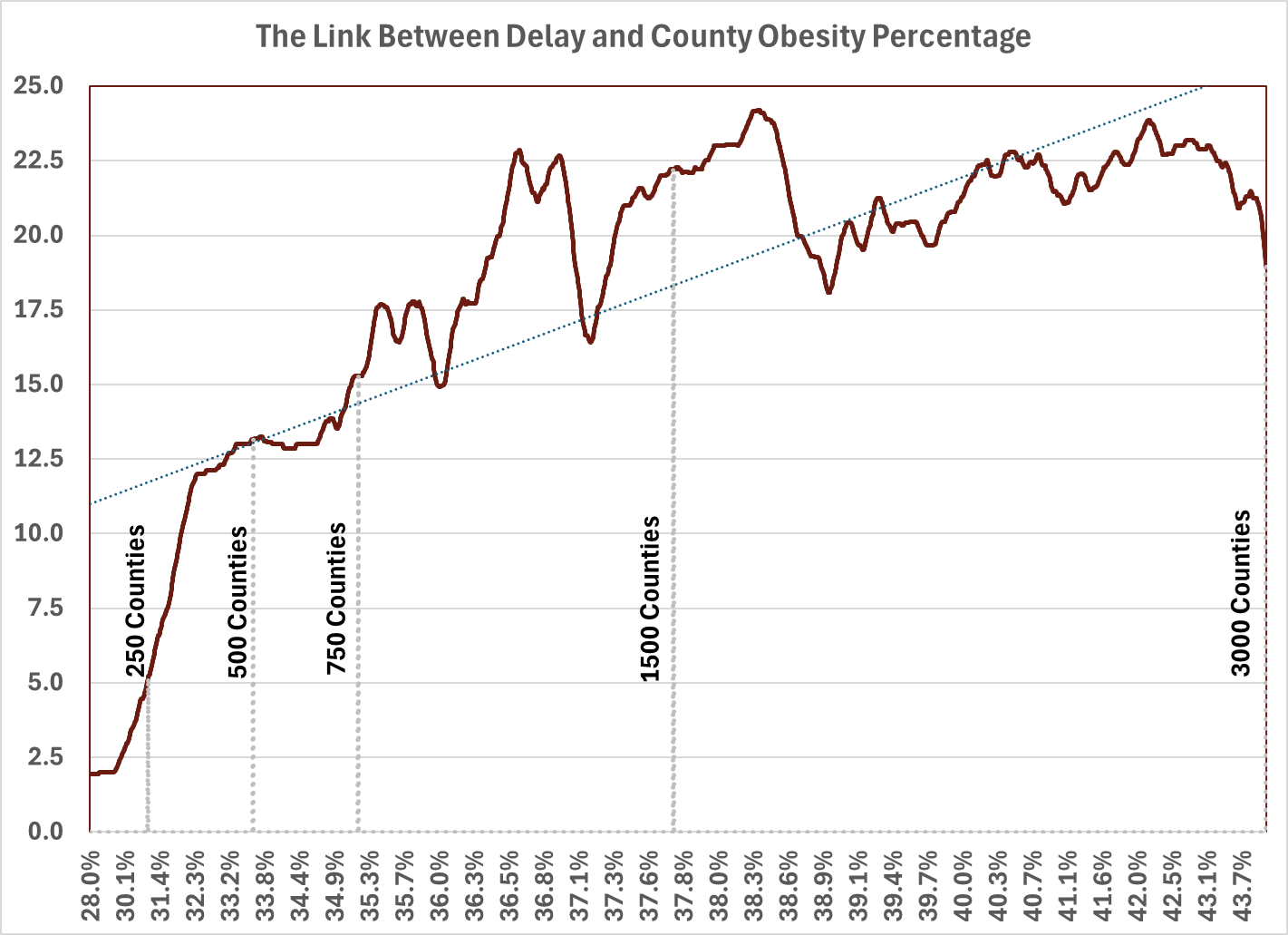 The method is simple, sensitive, and strong. Note that at Top 50, 100, and 250 Diabetes at medians of 5 or lower consistently has a strong circadian response.
By ratio, obesity is the highest ranked category for beneficial response from being in sync with the sun's light/dark cycle. Whether you look to sources on the web, on YouTube, or in scholarly literature, you will also find a potent link between obesity and circadian rhythms.
For example, we see in the graph that with very low percentages of obesity, delays are low. But delays sharply increase when this percentage increases, as does the reduced morning sunlight that comes with this progression. Instinctively, it is surprising that a component like delay would have such a formidable influence on body weight. Along these lines, studies show morning sunlight does influence weight gain.
Ratios in the table also illustrate relative strength in other categories. With the table you can get an intuitive feel for which health components tend to be most influenced by morning sunlight. For example, in the table we see median delay strongly acting on per capita personal income (high ratio) and to a lesser extent (low ratios) on no high school diploma and poverty, which are better observed elsewhere. Cognition at an intermediate ratio of 1.4 brings to mind the previously discussed college rankings.
It is especially interesting that leisure-time physical activity (LPA), the second highest ratio, shows such a strong pattern of low median delays. This flies in the face of the contention that DST increases physical activity by creating an extra hour of afternoon sunlight. To the contrary, the table shows that low delays and more morning sunlight increase the amount of leisure-time physical activity! Along the same lines, the literature routinely indicates that claimed exercise benefits from DST are at best modest and not universally supported.
The method is simple, sensitive, and strong. Note that at Top 50, 100, and 250 Diabetes at medians of 5 or lower consistently has a strong circadian response.
By ratio, obesity is the highest ranked category for beneficial response from being in sync with the sun's light/dark cycle. Whether you look to sources on the web, on YouTube, or in scholarly literature, you will also find a potent link between obesity and circadian rhythms.
For example, we see in the graph that with very low percentages of obesity, delays are low. But delays sharply increase when this percentage increases, as does the reduced morning sunlight that comes with this progression. Instinctively, it is surprising that a component like delay would have such a formidable influence on body weight. Along these lines, studies show morning sunlight does influence weight gain.
Ratios in the table also illustrate relative strength in other categories. With the table you can get an intuitive feel for which health components tend to be most influenced by morning sunlight. For example, in the table we see median delay strongly acting on per capita personal income (high ratio) and to a lesser extent (low ratios) on no high school diploma and poverty, which are better observed elsewhere. Cognition at an intermediate ratio of 1.4 brings to mind the previously discussed college rankings.
It is especially interesting that leisure-time physical activity (LPA), the second highest ratio, shows such a strong pattern of low median delays. This flies in the face of the contention that DST increases physical activity by creating an extra hour of afternoon sunlight. To the contrary, the table shows that low delays and more morning sunlight increase the amount of leisure-time physical activity! Along the same lines, the literature routinely indicates that claimed exercise benefits from DST are at best modest and not universally supported.
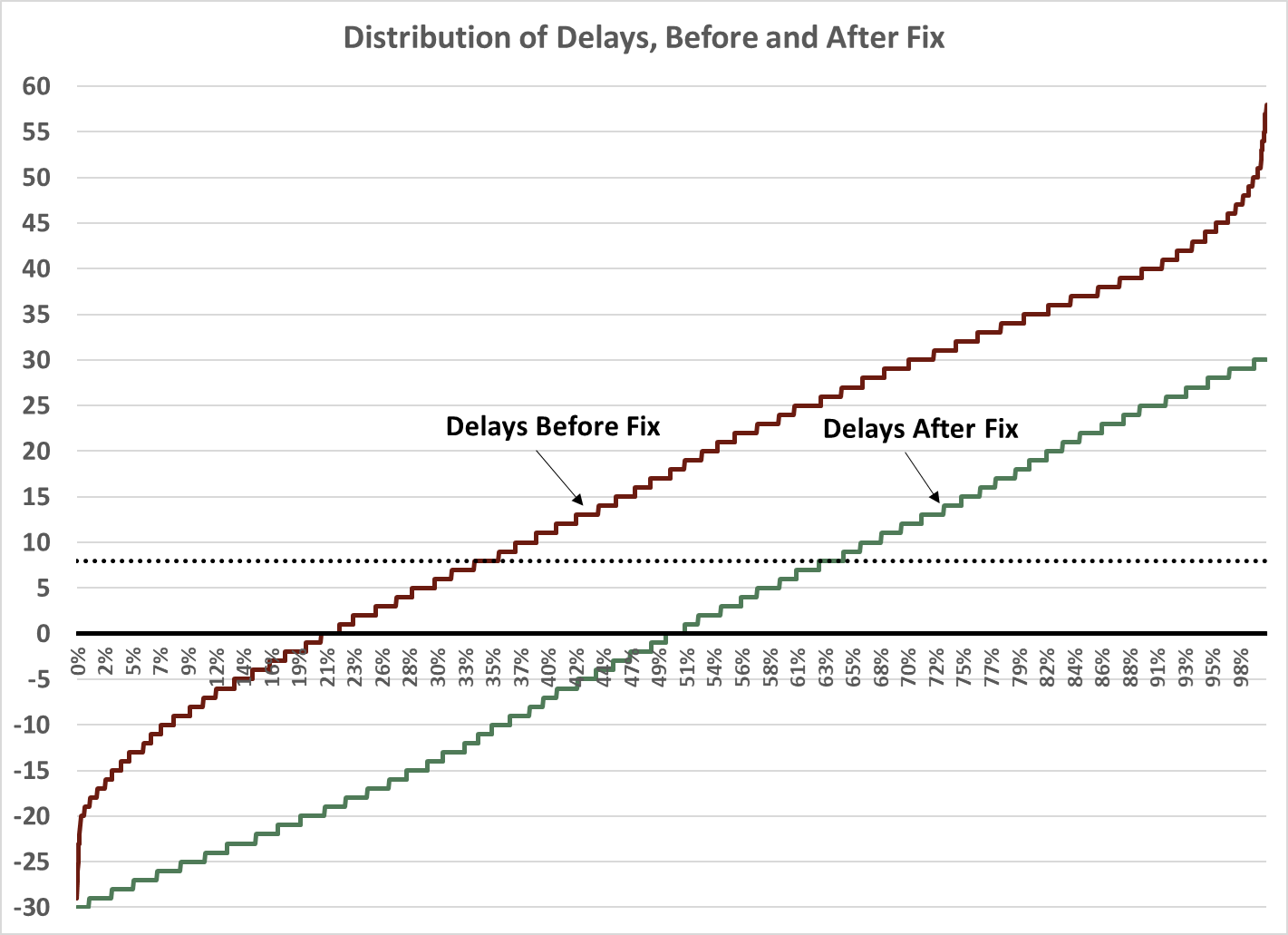 High delays come hand in hand with poorer outcomes. From the perspective of health and personal income, long DSTs and improper time zones are a catastrophe.
Top performing ranks have low delays. By living in a low delay location, a person can enjoy benefits in widespread categories. On the other hand, someone who lives in a high-delay area can not enjoy this broad range of opportunity. They are stuck without equal ability to achieve high rank in a wide variety of categories.
As illustrated in the graph, with the current DST and time zones, now only 34% of counties can deliver 8-minute delays. We are hamstrung. Fortunately, with a DST/time-zone fix, 63% of counties can easily deliver 8-minute delays.
If, for a county, your objective in a category is, for example, to perform at the Top 250 level in many categories, you typically would want your county to have a median delay equal to or less than the one shown in the table — an 8 minute median delay and 36% dark mornings seemingly being an adequate objective in many categories.
To get to this point often requires a time-zone/DST fix. You see, delay is caused by your location. Beyond this, major changes in delay and features of the light/dark cycle must come from legislated components, specifically: time zones and DSTs.
High delays come hand in hand with poorer outcomes. From the perspective of health and personal income, long DSTs and improper time zones are a catastrophe.
Top performing ranks have low delays. By living in a low delay location, a person can enjoy benefits in widespread categories. On the other hand, someone who lives in a high-delay area can not enjoy this broad range of opportunity. They are stuck without equal ability to achieve high rank in a wide variety of categories.
As illustrated in the graph, with the current DST and time zones, now only 34% of counties can deliver 8-minute delays. We are hamstrung. Fortunately, with a DST/time-zone fix, 63% of counties can easily deliver 8-minute delays.
If, for a county, your objective in a category is, for example, to perform at the Top 250 level in many categories, you typically would want your county to have a median delay equal to or less than the one shown in the table — an 8 minute median delay and 36% dark mornings seemingly being an adequate objective in many categories.
To get to this point often requires a time-zone/DST fix. You see, delay is caused by your location. Beyond this, major changes in delay and features of the light/dark cycle must come from legislated components, specifically: time zones and DSTs.
Perpetuating DST Wings and Corrupted Time Zones.
To perform at a Top 250 level often requires that your location have a delay not higher than 8 or 36% dark mornings. We need to be clear. Low delays like 8 can be required for a Top 250 level of superior performance across many categories, the Combo-8 being just one example of widespread influence.
Yet, with current time zones and DST, two-thirds of all counties are now completely unable!! to get down to the 8-delay or the 36% point, despite Top 250 levels of performance often requiring it. With this, they are more likely to be stuck at lower performance levels indicated in the table.
Perpetuating DST wings and corrupted time zones prevents breaking through the 8-delay, 36%-barrier. Whereas, with the wings and corrupted time zones removed, literally every American has dark mornings capped at a 37% maximum, effectively equal to the current median 8-delay's 36%.
Details aside, being capped at 37% is the safe position. It works. It employs the same data used in the interactive maps. This sea change in many categories provides increased opportunity for a Top 250 level performance for all Americans, not just the lucky few now living at locations with an 8-delay median or lower.
Plain, simple, and crucial. The fine edge of reason is whether to have: More Top 250 Level Performance, or Wings and Corrupted Time Zones.
Similarly in this graph, we find high delays at reduced longevity. For the 165 million people at segment delays 17 and 20 in the table, life expectancies plummet. Hand in hand, high delays come with reduced longevity. Again, high delays coming from corrupted time zones & the current DST contribute to an unfavorable outcome.
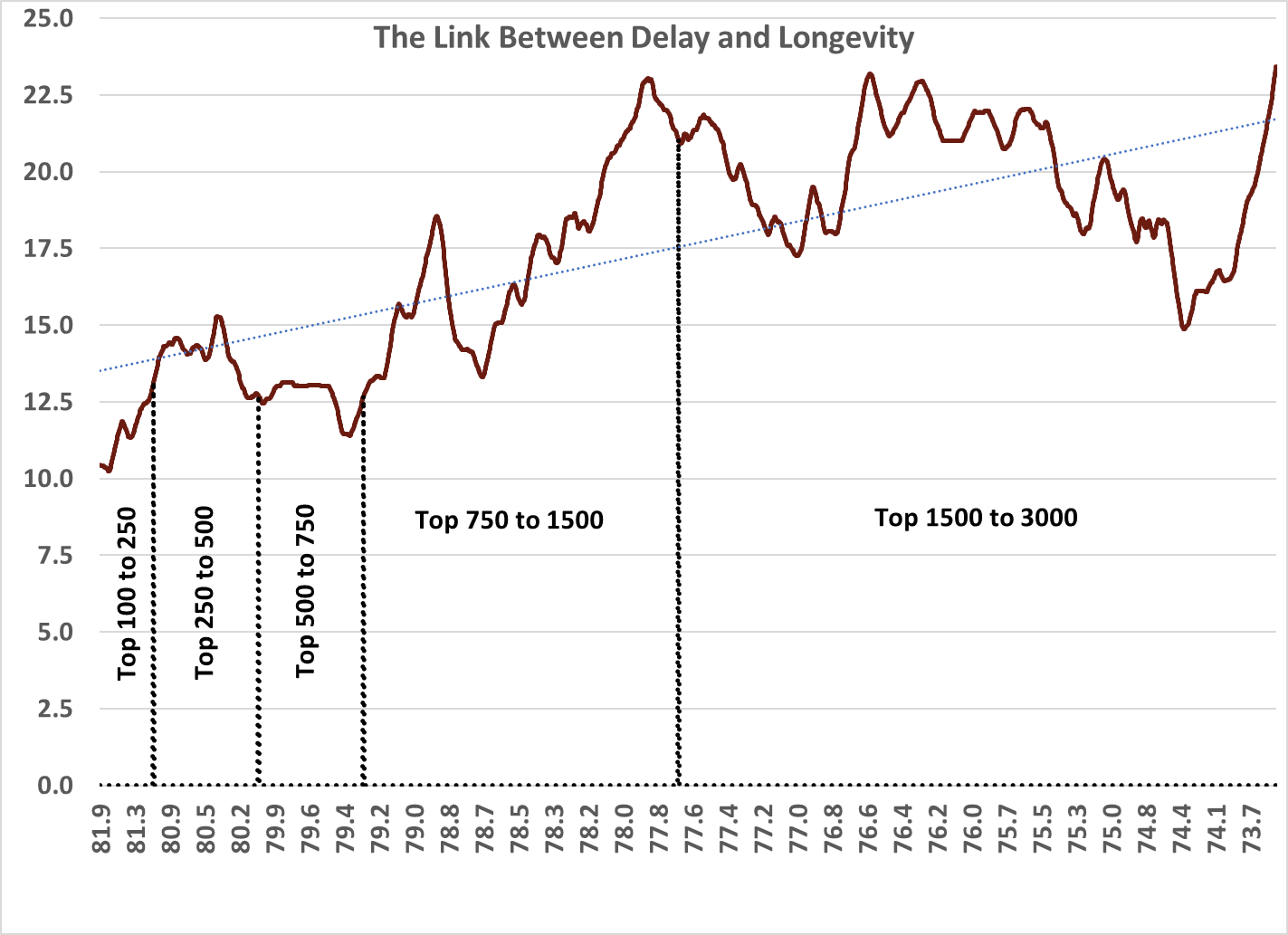 [Spreadsheet notes: Life expectancy estimates 2000-2019, both sexes. High accuracy life-expectancy data to fraction of a year. To reduce
[Spreadsheet notes: Life expectancy estimates 2000-2019, both sexes. High accuracy life-expectancy data to fraction of a year. To reduce
confounding elements limited data to white race. In graph, centered rolling 200-point median, smoothed on 30-point centered moving average.]
The deeper we look, the more we find that together with worsened health and reduced life expectancy come high delays. Being in sync matters.
Circadian Impact on Real Estate, Towns, Cities, and Counties …
In the following sections we turn attention to real estate, counties, and cities. Whether we look at cities in general or real estate in particular, we see that being out of sync has a measurable impact. This graph shows real-world median home values, which now apply.
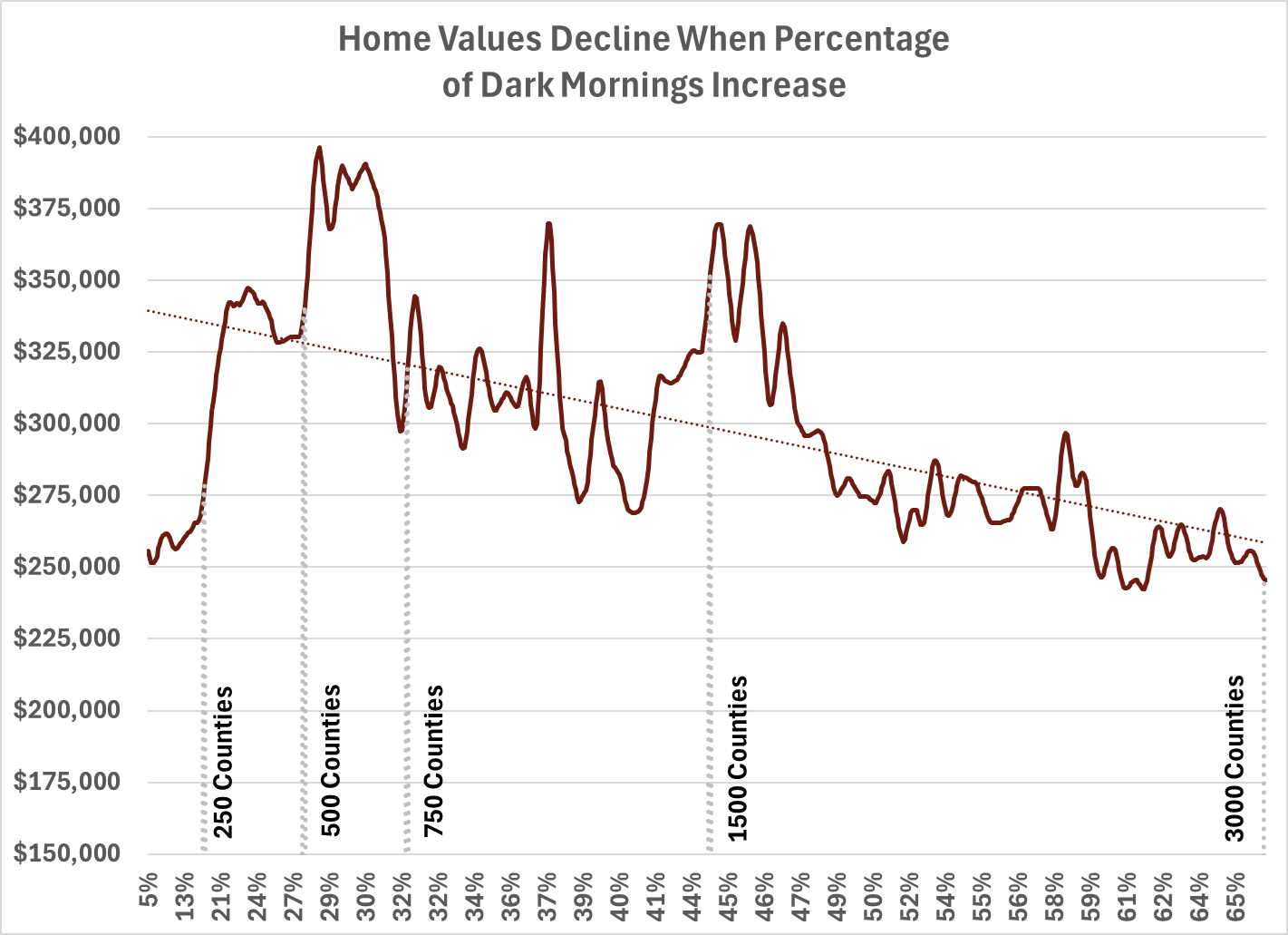 [Spreadsheet notes: Census, American Community Survey, B25077 Median Value.
[Spreadsheet notes: Census, American Community Survey, B25077 Median Value.
In graph, centered rolling 56-point median, smoothed on 9 point centered moving average. Census reports 835 of all 3,000 counties; number of counties reported in this graph therefore scaled.]
Unknowingly, folks pay a premium for homes with low delays and few dark mornings. To the surprise of most of us, as seen in the graph, your home tends to be worth more when it is at a location with few dark mornings and its value suffers when many early mornings are dark. Again, the greater the percentage of dark mornings, the greater the harm.
Under natural conditions, at the median, about 19% of mornings are dark. When morning darkness brought on by improper time zones and long DSTs greatly exceed this figure, the trendline goes south, at an extreme point reducing median value by about $75,000. The reduction in value is not magic. The reasons for the decline become increasingly clear as we discuss the impact of dark mornings.
The loss is pointless. After all, before long DSTs and improper time zones were invented, dark mornings, without exception, were naturally absolutely capped at a 37% maximum for all Americans. Locked at the 37% of dark mornings shown in the graph, harm would be removed and trendline price differences would tend to be acceptably small.
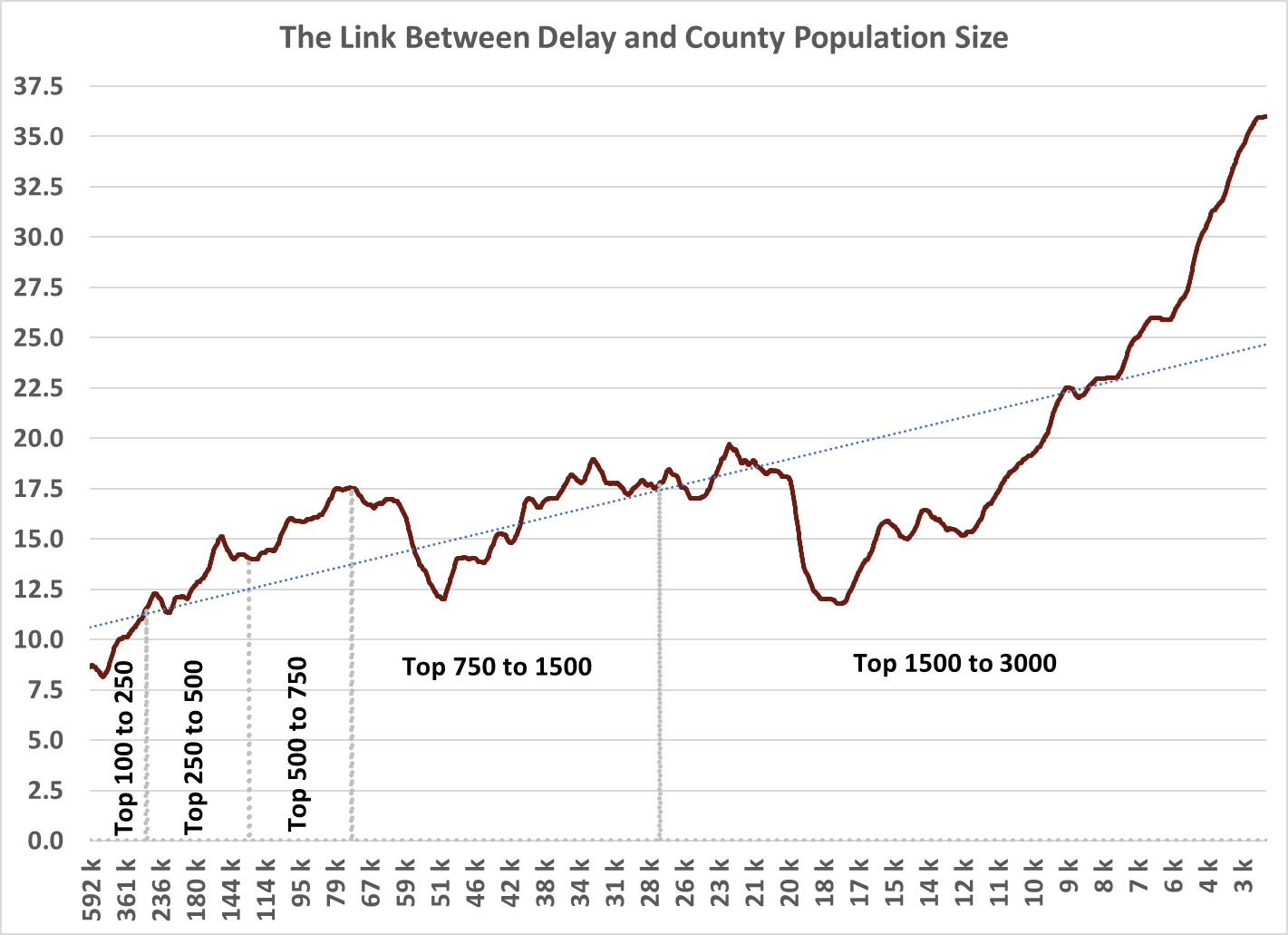
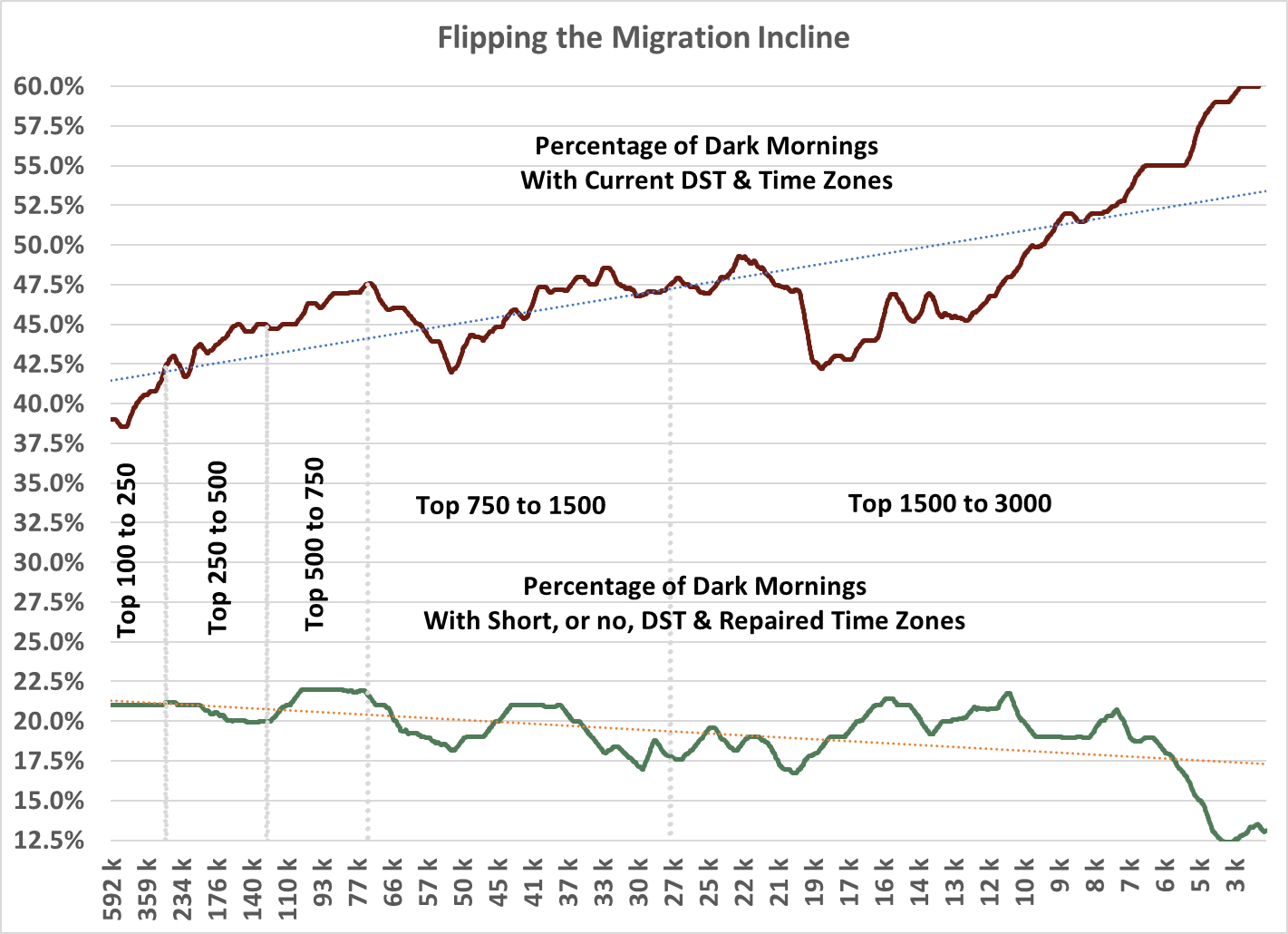
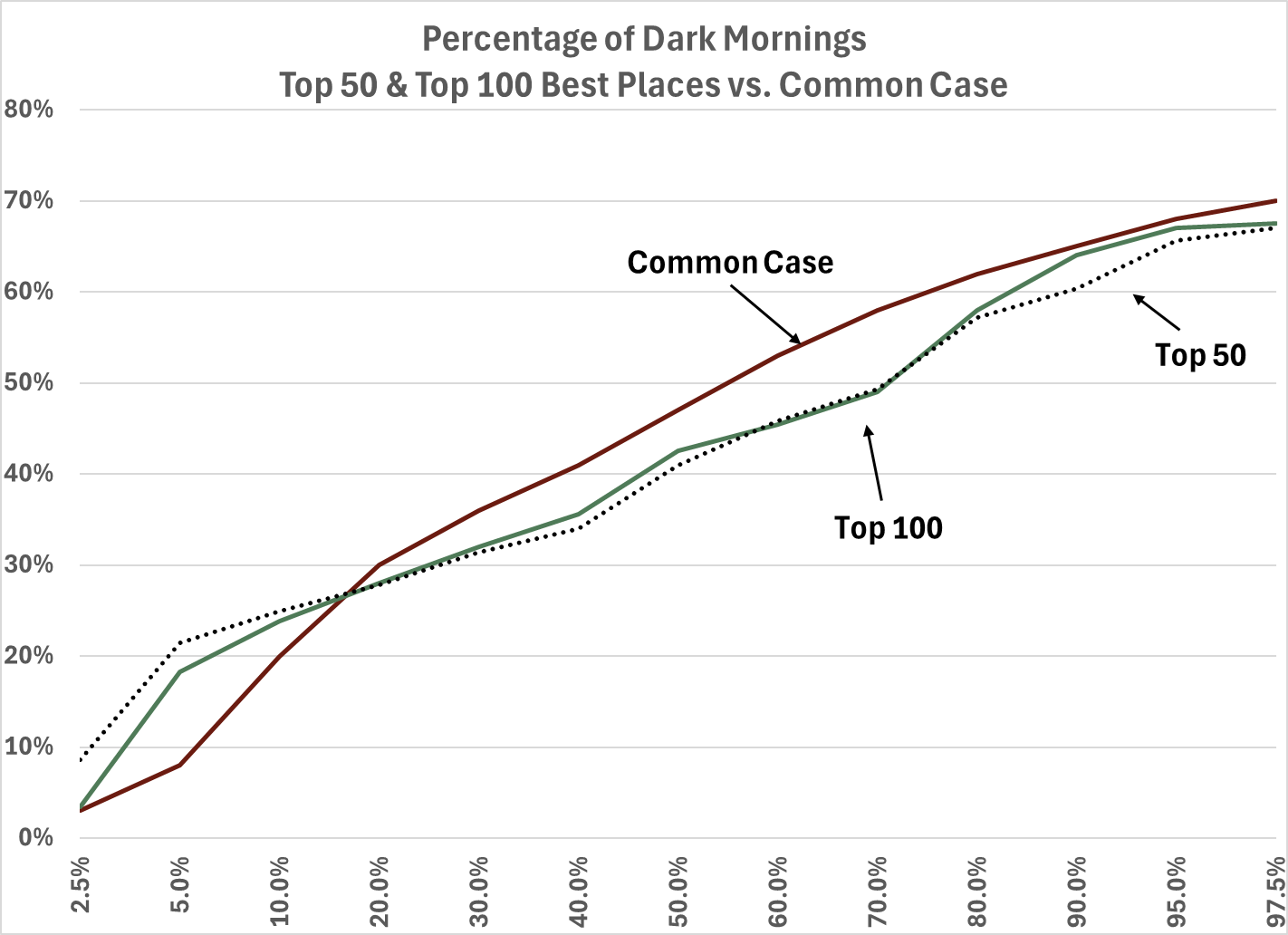
Because they are decidedly more desirable than the average, these cities are excellent for analysis. We find that they, too, unwittingly benefit from lower delays and fewer dark mornings. At the Top 50 level, their median delay is 8 minutes less and their percentage of dark mornings is 6% lower than the common case. Just as in health rankings, lower delays and fewer dark mornings for cities tend to come hand in hand with superior performance.
It is of interest that the counties in the prior Top 100 to 250 group have a segment 10-delay as do the 100 select cities here. The low delay and bright mornings may well have been contributing to these cities being attractive. With low delays, the real-estate mantra — "Location, Location, Location" — seems to carry additional weight.
Perhaps this is not such a surprise. Again looking at home values, we see values in this graph linked to delay and attending dark mornings. As delays increase home values decline. This suggests that characteristics of delay locations are directly or indirectly perceived and that subliminally low delay's desirable consequences are highly valued.
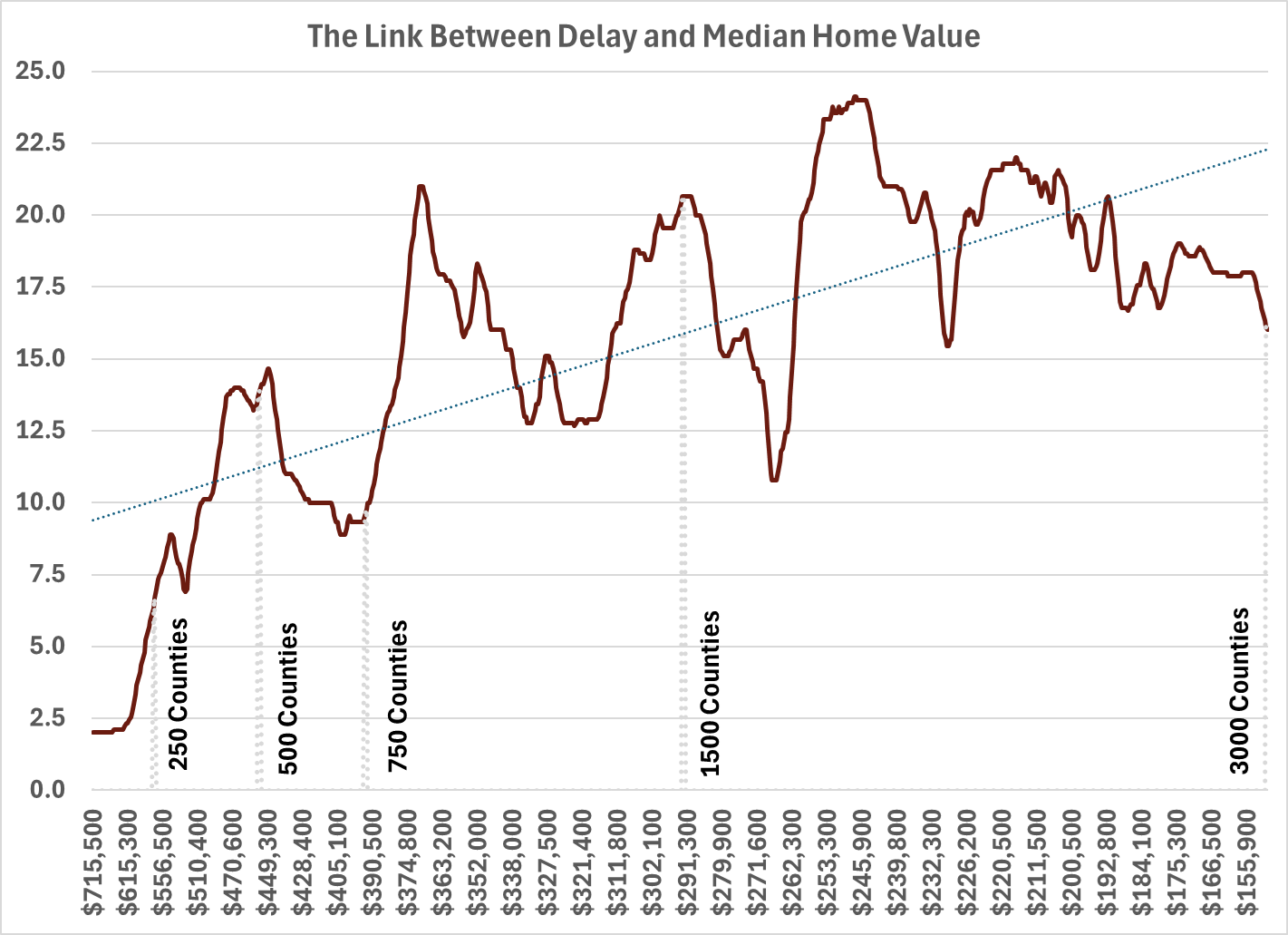
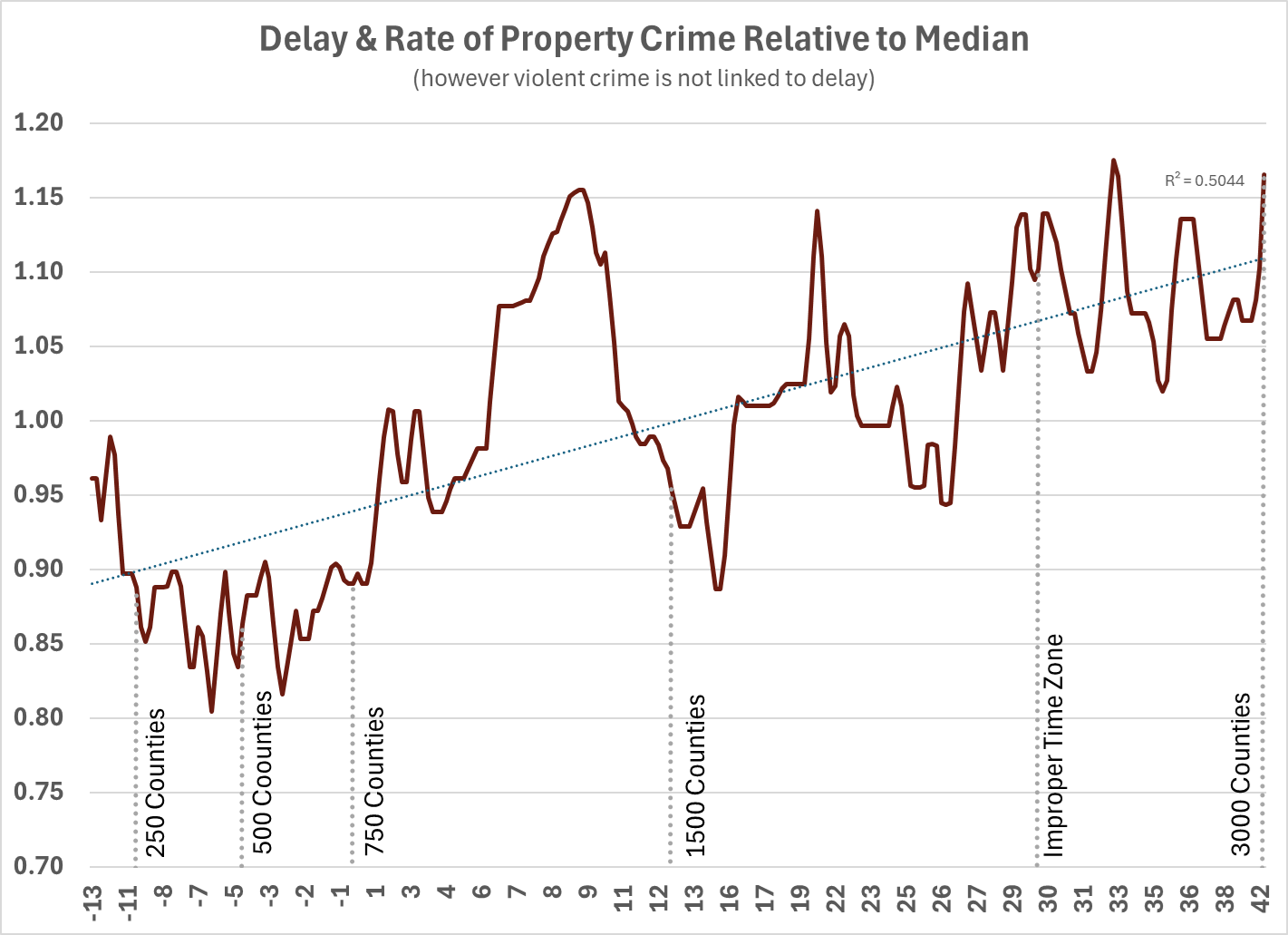 [Spreadsheet notes: Get Delay by formula. Sort data on delay. Graph centered on rolling 56-point median, smoothed on 3-point centered moving average.
[Spreadsheet notes: Get Delay by formula. Sort data on delay. Graph centered on rolling 56-point median, smoothed on 3-point centered moving average.
Only 290 MSA data points readily available to public, in contrast to 3,000+ county-level FIPS points at CDC.
This precludes detailed analysis. Data source: crime-in-the-u.s.-2019.]
Independent of correlation, we see that existing property crime tends to increase as delay increases — low crime at low delays, higher crime at high delays. Just one more incentive to reject improper time zones.
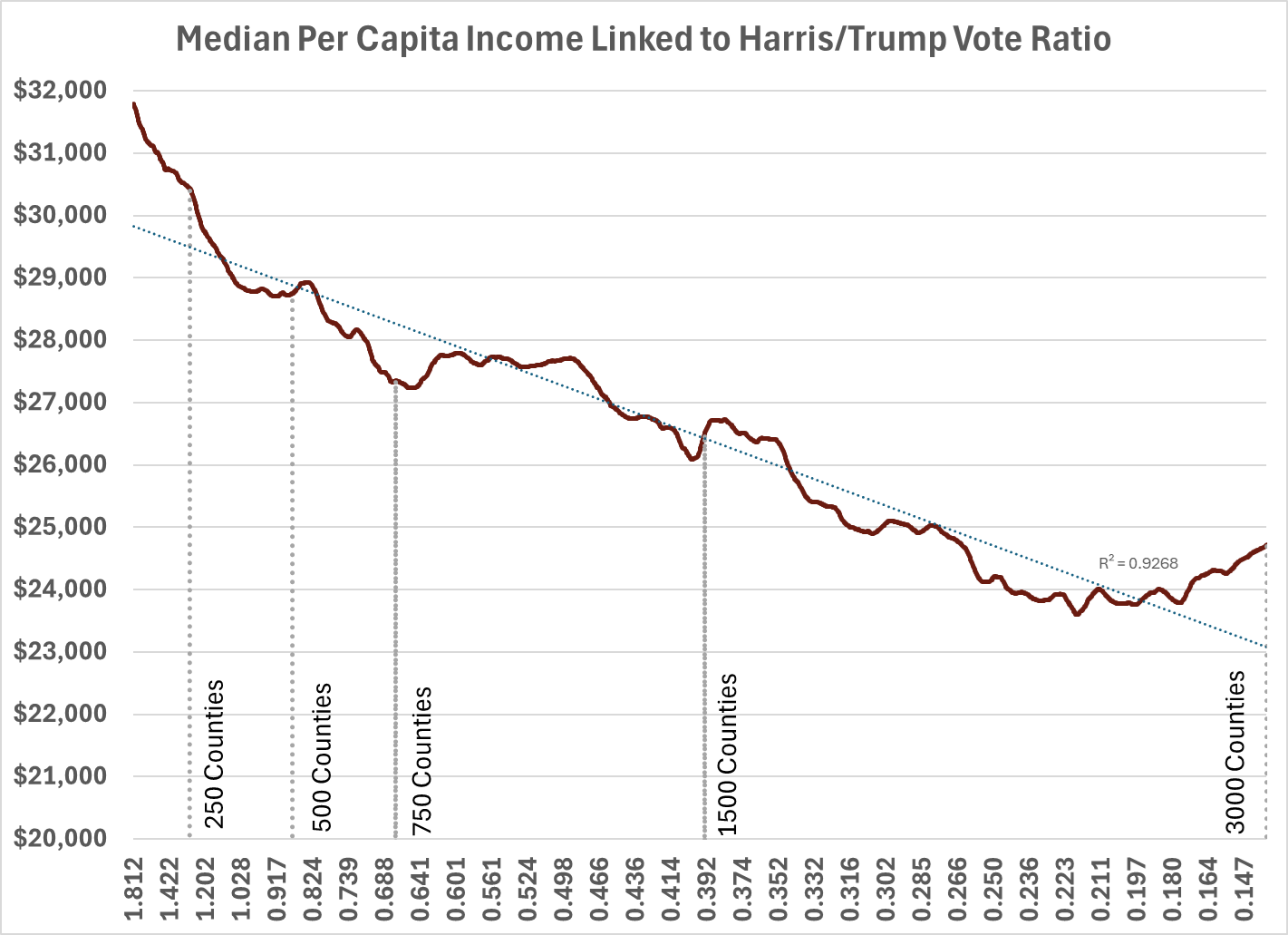
The main story is that there seems to be an astonishingly tight relationship between the Harris/Trump Vote Ratio and delay, as shown in the following graph and table. The table is sorted on the Harris/Trump vote ratio.
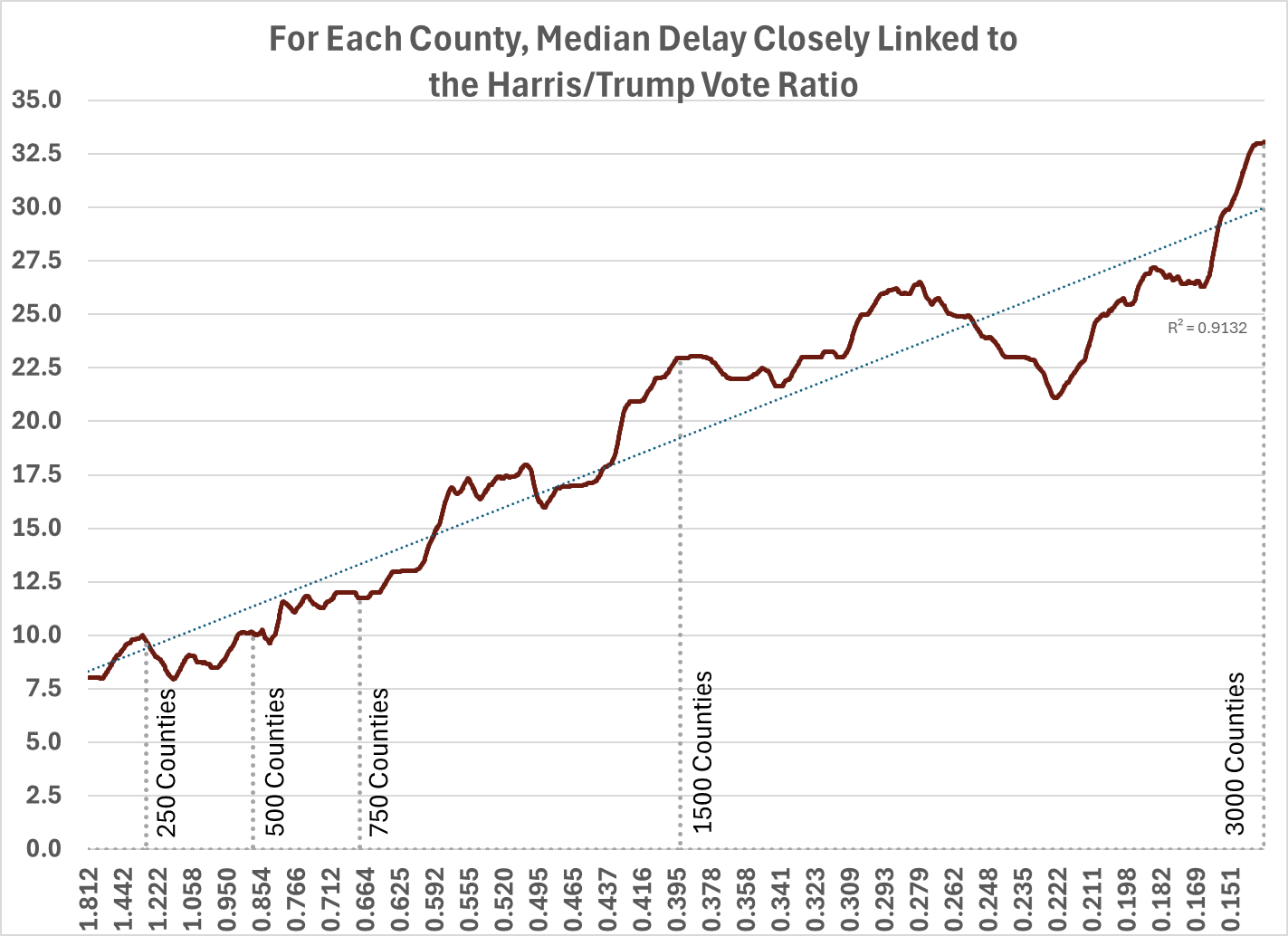
[Spreadsheet notes: Delay data from original computer program that developed the maps. Sort data on Harris_vote/Trump_vote Ratio. Graph centered on rolling 200-point median, smoothed on 30-point centered moving average. Note: Average income is about $450 more than median. Rank ratio 2.4 is equal to highest health ratio (obesity) shown earlier. For graphs in this section, population & income from pre-COVID, CDC Social Vulnerability Index 2018. Vote source: Dave Leip's Atlas of U.S. Presidential Elections, Preliminary data, downloaded 11/13/2024.]
Harris won roughly 400 of 3,000 counties.
Wide median differences exist between Harris and Trump locations:
Harris 8-delay, 39% dark mornings, $30,704 per capita income, and $5.6 trillion total personal income in 400 counties.
Trump 21-delay, 50% dark mornings, $25,941 per capita income, and $4.7 trillion total personal income in 2,600 counties. At a median 8-delay, Harris counties are characterized by being in sync. At a median 21-delay, Trump counties are characterized by being out of sync. Being out of sync, evidenced by high delays and a high percentage of dark mornings, typically produces adverse outcomes. In the table here, median segment delays of 17 and 23 at "Top 750 to 1500" and higher are especially harmful. The following three graphs answer the crucial question, "What are the average economic and election outcomes when given specific delays?" See the similarity of shape. Population and Total Personal Income patterns look much the same. The long-term player, in this instance, population, is author of the shape. As does circadian impact, it builds over many years. In all instances of existing conditions here there is a trendline decline from low delay to high delay. An entirely neglected voice, "delay," contributes at both ends of the curves. High on the left, low on the right.
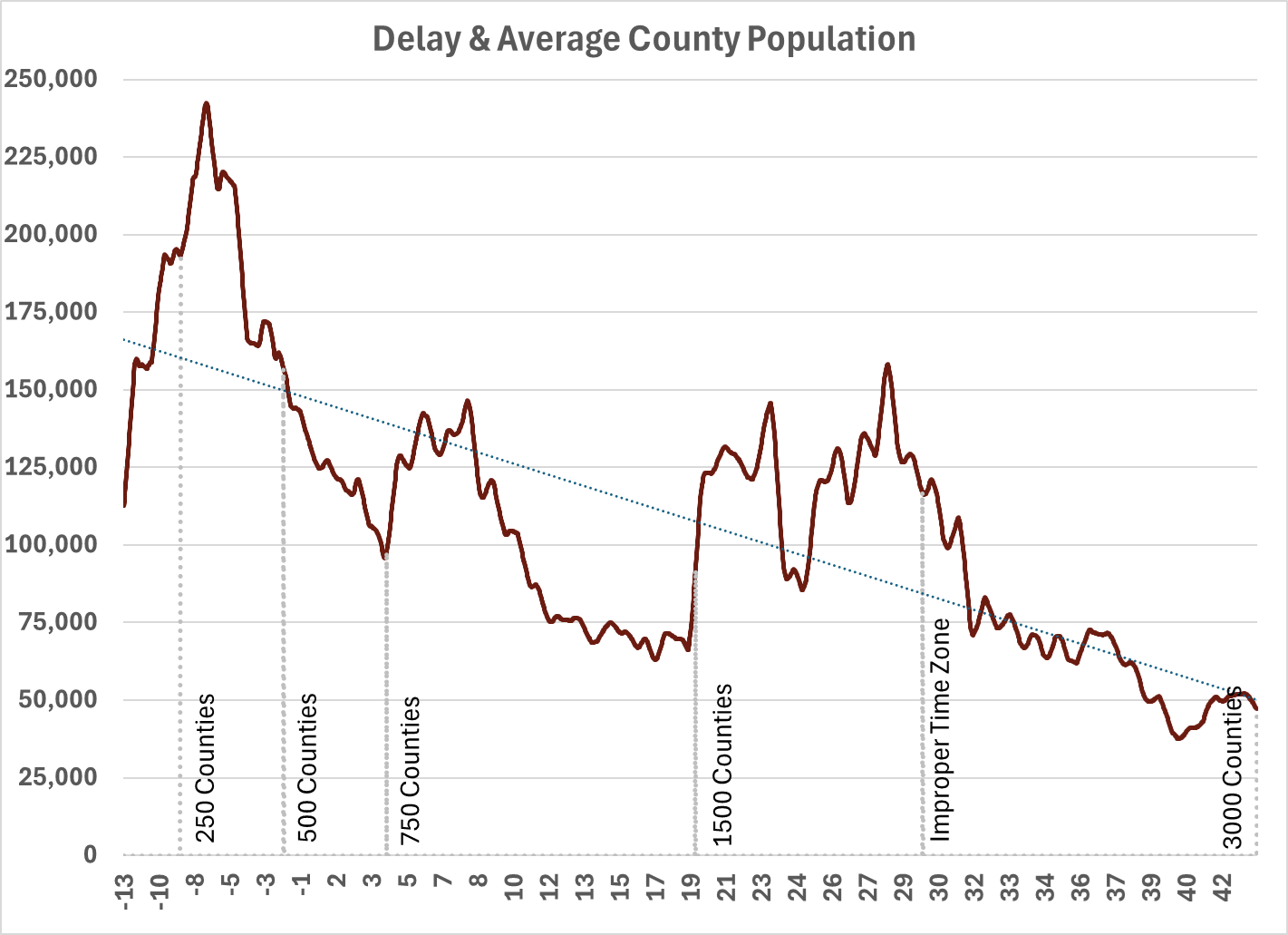
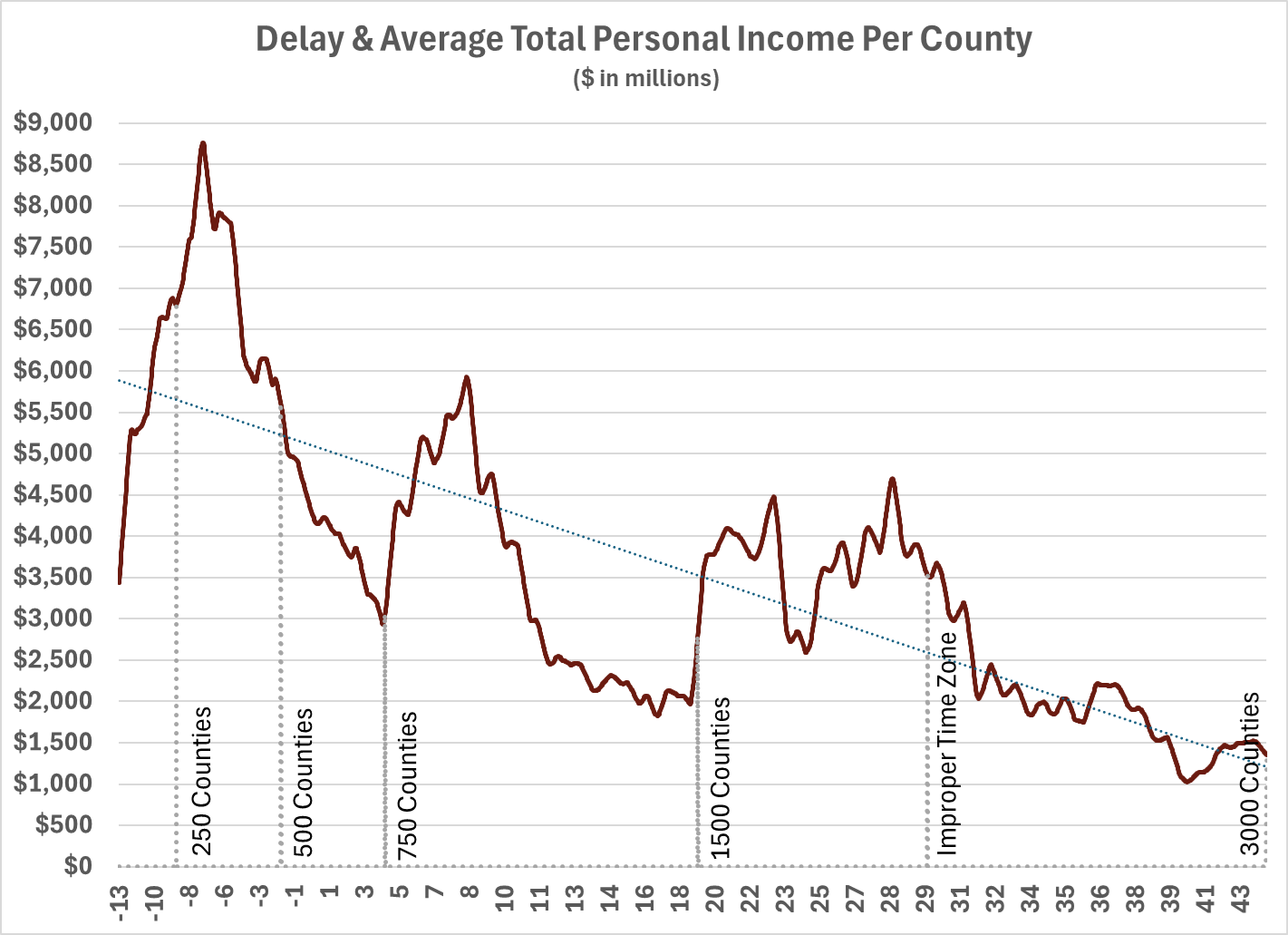 [Spreadsheet notes: Get delay by formula. Sort data on delay. Graphs centered on rolling 200-point average, smoothed on 30-point centered moving average.]
In the above, the average delay in the Top 750 counties is a negative 5.8. With it come the nation's greatest success.
In a polar opposite position, starting at a 33-delay, the bottom 750 counties (to the right of the improper time zone marker) come with an exceptionally high average delay of 40. With it we have the nation's weakest economic performance.
[Spreadsheet notes: Get delay by formula. Sort data on delay. Graphs centered on rolling 200-point average, smoothed on 30-point centered moving average.]
In the above, the average delay in the Top 750 counties is a negative 5.8. With it come the nation's greatest success.
In a polar opposite position, starting at a 33-delay, the bottom 750 counties (to the right of the improper time zone marker) come with an exceptionally high average delay of 40. With it we have the nation's weakest economic performance.
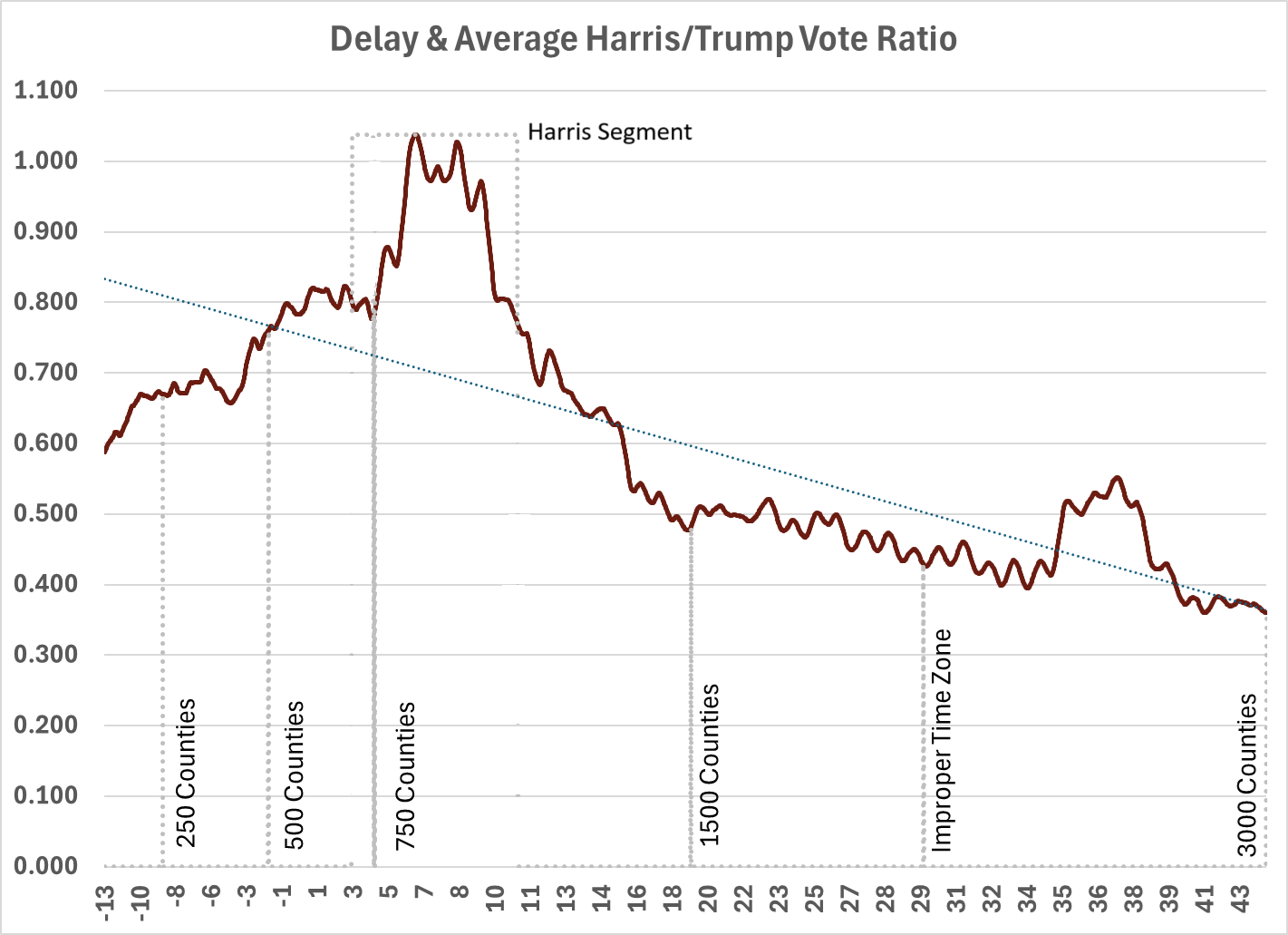 The relationship between the Harris/Trump Vote Ratio and delay, i.e., sync, tells a great deal. The Harris/Trump Vote Ratio would have required a ratio greater than one for Harris to have a win. In the above, we see Harris's penetration is weak outside the 400-county Harris segment shown here (3-delay to 11-delay range, nationwide a median 8-delay).
To the right of the Harris Segment, at an 11-delay, the curve shows Harris support declining at increasingly high delays.
By a 19-delay, in about half of all counties, the Harris/Trump ratio is typically 0.500 or lower, which is to say for every 5 Harris voters there are at least 10 Trump voters in these counties. By the low end of the trendline, it is closer to 4 Harris voters for 10 Trump voters.
Here and elsewhere in this discussion, social, economic, and election decision-making appear to be influenced by delay — not by magic but, in part, seemingly via excessive dark mornings and subtle consequences of circadian influence.
Outside the context of an election, low delays and few dark mornings are imperative. Otherwise, in many categories top performance is suppressed. The downward trendlines here and accompanying gloomy mornings lead to a bleak set of conditions.
On the other hand, as shown in the above table's After Fix column, dark mornings can be easily limited to a safe, narrow band of median dark mornings lower than 28%.
That said, election components related to delay and morning darkness are speculative and have not been adequately studied, so it is difficult to draw conclusions at this point.
The relationship between the Harris/Trump Vote Ratio and delay, i.e., sync, tells a great deal. The Harris/Trump Vote Ratio would have required a ratio greater than one for Harris to have a win. In the above, we see Harris's penetration is weak outside the 400-county Harris segment shown here (3-delay to 11-delay range, nationwide a median 8-delay).
To the right of the Harris Segment, at an 11-delay, the curve shows Harris support declining at increasingly high delays.
By a 19-delay, in about half of all counties, the Harris/Trump ratio is typically 0.500 or lower, which is to say for every 5 Harris voters there are at least 10 Trump voters in these counties. By the low end of the trendline, it is closer to 4 Harris voters for 10 Trump voters.
Here and elsewhere in this discussion, social, economic, and election decision-making appear to be influenced by delay — not by magic but, in part, seemingly via excessive dark mornings and subtle consequences of circadian influence.
Outside the context of an election, low delays and few dark mornings are imperative. Otherwise, in many categories top performance is suppressed. The downward trendlines here and accompanying gloomy mornings lead to a bleak set of conditions.
On the other hand, as shown in the above table's After Fix column, dark mornings can be easily limited to a safe, narrow band of median dark mornings lower than 28%.
That said, election components related to delay and morning darkness are speculative and have not been adequately studied, so it is difficult to draw conclusions at this point.
A Room Full of Elephants. There is only a slight difference between exclusively repairing time zones and exclusively eliminating long DSTs. Attending to DST alone leaves almost half the job undone. As measured by changes in number of dark mornings, eliminating long DSTs has only a 14% advantage over repairing time zones [=1.74/1.52]. Repairing both together has a 2.5x advantage [=172/69]. As to the impact of time zones, by virtue of their 365-day length, they keep us out of sync 1.5x longer than the current DST [=365/239]. And then there is the question of choosing a DST length, a topic on which surprisingly no ink is spilled.
Regional considerations also come into play. In the dead of winter, an inappropriate time zone increases winter morning coldness. Since the current DST is inactive during these coldest days of winter, it does not. For this reason, greatest payoff in northern regions often comes from fixing an inappropriate time zone.
By a large margin, as measured by minutes of delay, the current DST and inappropriate time zones have put us out of sync with time. However you choose to make comparisons, the impacts are gargantuan, involving many millions of people. The misalignment is unnecessary.
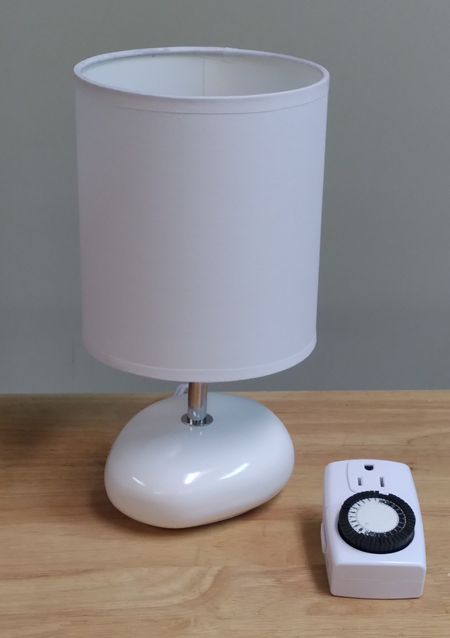
 With all the gadgets of modern life the lowly sundial, set to local solar time, provides a nice connection with a higher authority. The honest sun. When its shadow strikes 12, we have an apt reminder that half the day is done and another half awaits us. This, punctuated with lunch at solar noon, provides a reliable regularity, a perceived as well as an unconscious orderliness as the day unfolds.
Bedside & table lamps and mechanical timers can provide a consistent, unobtrusive year-round assist for maintaining sync. [Warm 4 watt incandescent, candelabra E12 bulb for dim light, 7 watt for brighter light, or 7.5 watt incandescent for conventional E26 socket.]
A long wait between last meal of the day and bedtime is often recommended. Timer set to turn on: 1) for the appropriate lunch hour, and 2) during the dinner-to-bedtime period (for example, 5:30 PM to 10:30 PM).
This can provide sufficient cues to nudge us into an appropriate, year-long mealtime and sleep routine. Begin meal when light turns on. Head to bed when light turns off at night.
The evening light-on period provides warm, dim lighting in preparation for sleep and does double duty as a night light.
With all the gadgets of modern life the lowly sundial, set to local solar time, provides a nice connection with a higher authority. The honest sun. When its shadow strikes 12, we have an apt reminder that half the day is done and another half awaits us. This, punctuated with lunch at solar noon, provides a reliable regularity, a perceived as well as an unconscious orderliness as the day unfolds.
Bedside & table lamps and mechanical timers can provide a consistent, unobtrusive year-round assist for maintaining sync. [Warm 4 watt incandescent, candelabra E12 bulb for dim light, 7 watt for brighter light, or 7.5 watt incandescent for conventional E26 socket.]
A long wait between last meal of the day and bedtime is often recommended. Timer set to turn on: 1) for the appropriate lunch hour, and 2) during the dinner-to-bedtime period (for example, 5:30 PM to 10:30 PM).
This can provide sufficient cues to nudge us into an appropriate, year-long mealtime and sleep routine. Begin meal when light turns on. Head to bed when light turns off at night.
The evening light-on period provides warm, dim lighting in preparation for sleep and does double duty as a night light.
Teenagers particularly are harmed by long DSTs and inappropriate time zones. Most now get only about 6.5-7.5 hours sleep per night – far less than their recommended hours. Their body clocks, influenced by DST and time zones, naturally shift to make them feel tired later in the evening, but early school starts do not enable them to sleep in the mornings. Adolescents who sleep for longer – and from an earlier bedtime – than their peers tend to have improved brain function and perform better at cognitive tests. The literature along these lines is vast.
Now, let's consider your preferred time to go to bed in a world in which there are no DSTs or improper time zones. Let's say in this hypothetically pure world, your preferred time for shut-eye is an unadulterated proper time of 10:30 PM.
If these circumstances are seen from a DST perspective, your preferred bedtime instead would appear to be 11:30 PM, a Night Owl. From a perspective of DST combined with an improper time zone, your preferred bedtime would appear to be even later, 12:30 AM, again a Night Owl. Your modest and sensible intention of simply choosing a proper 10:30 PM bedtime calls you a Night Owl in either of these two cases.
The term Night Owl may be saying something about social time, but it is on less firm ground when it comes to fundamental conditions. We are separated from the natural unfolding of the day to the extent that often we cannot recognize its underlying time. Layers of adulteration have created a fictitious time, a time distorted to such an extent that not only new seasons of winter morning darkness have been created, but even ordinary events, such as identifying bedtime, have become needlessly confusing, often misleading.
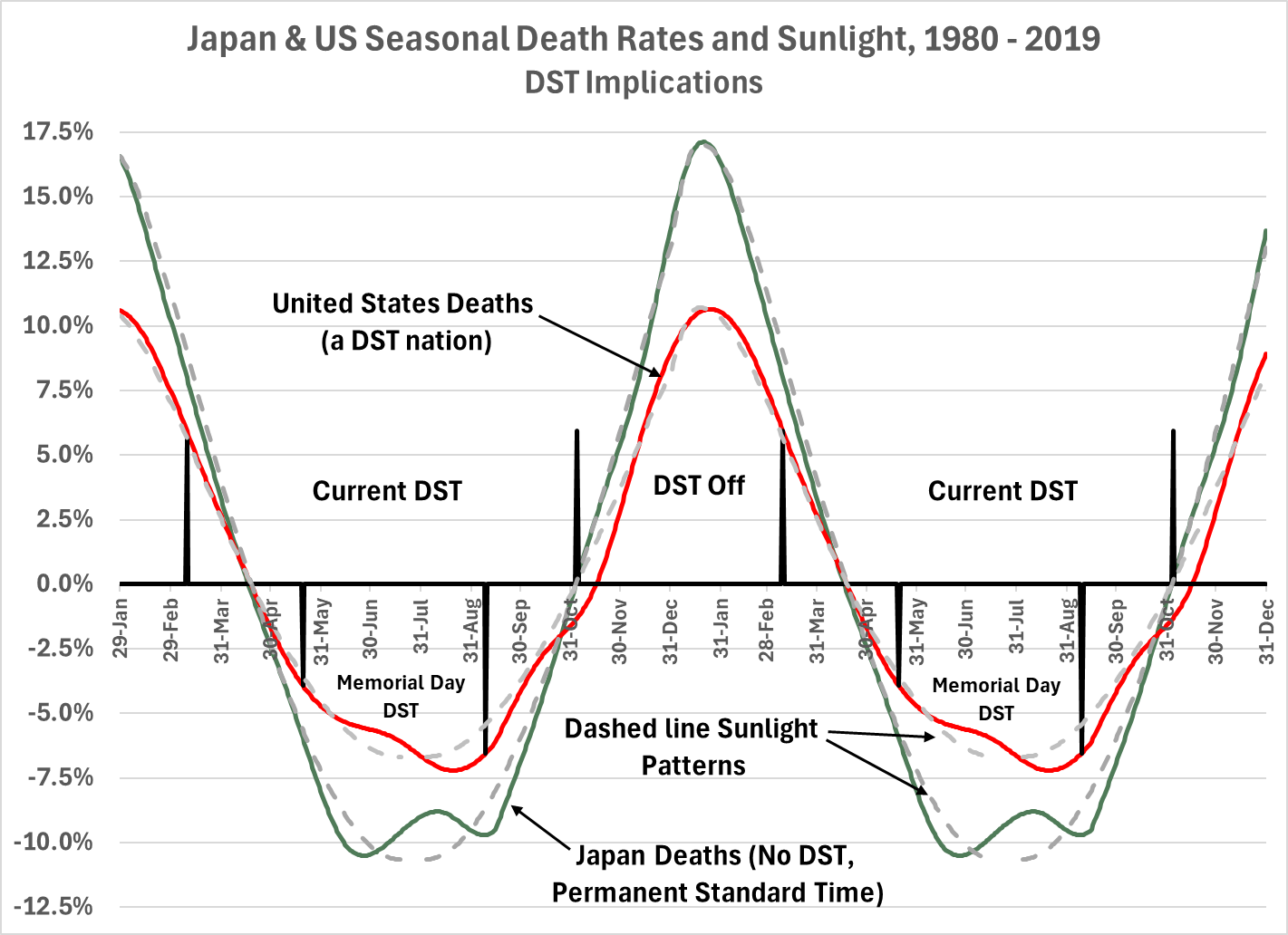
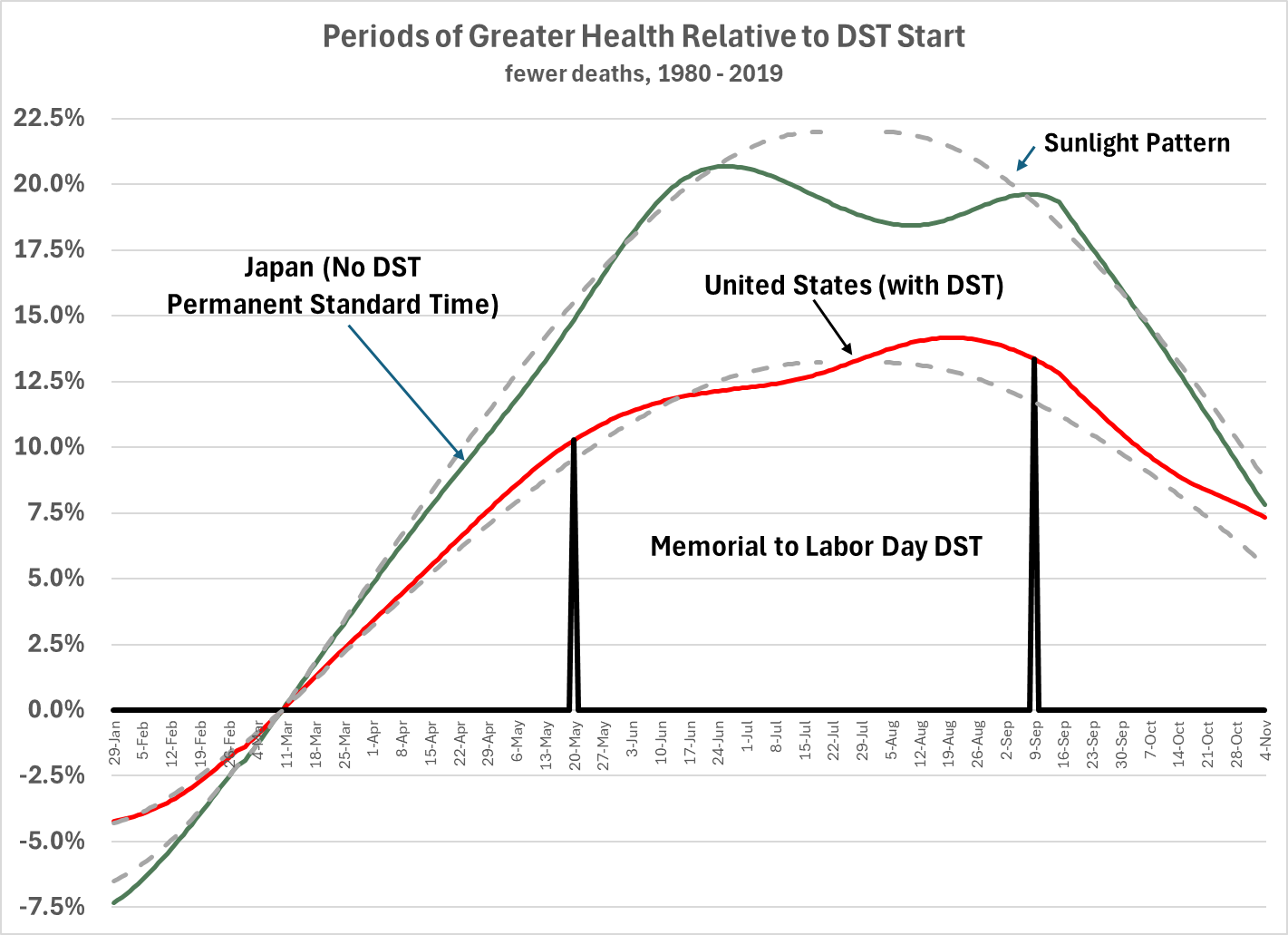
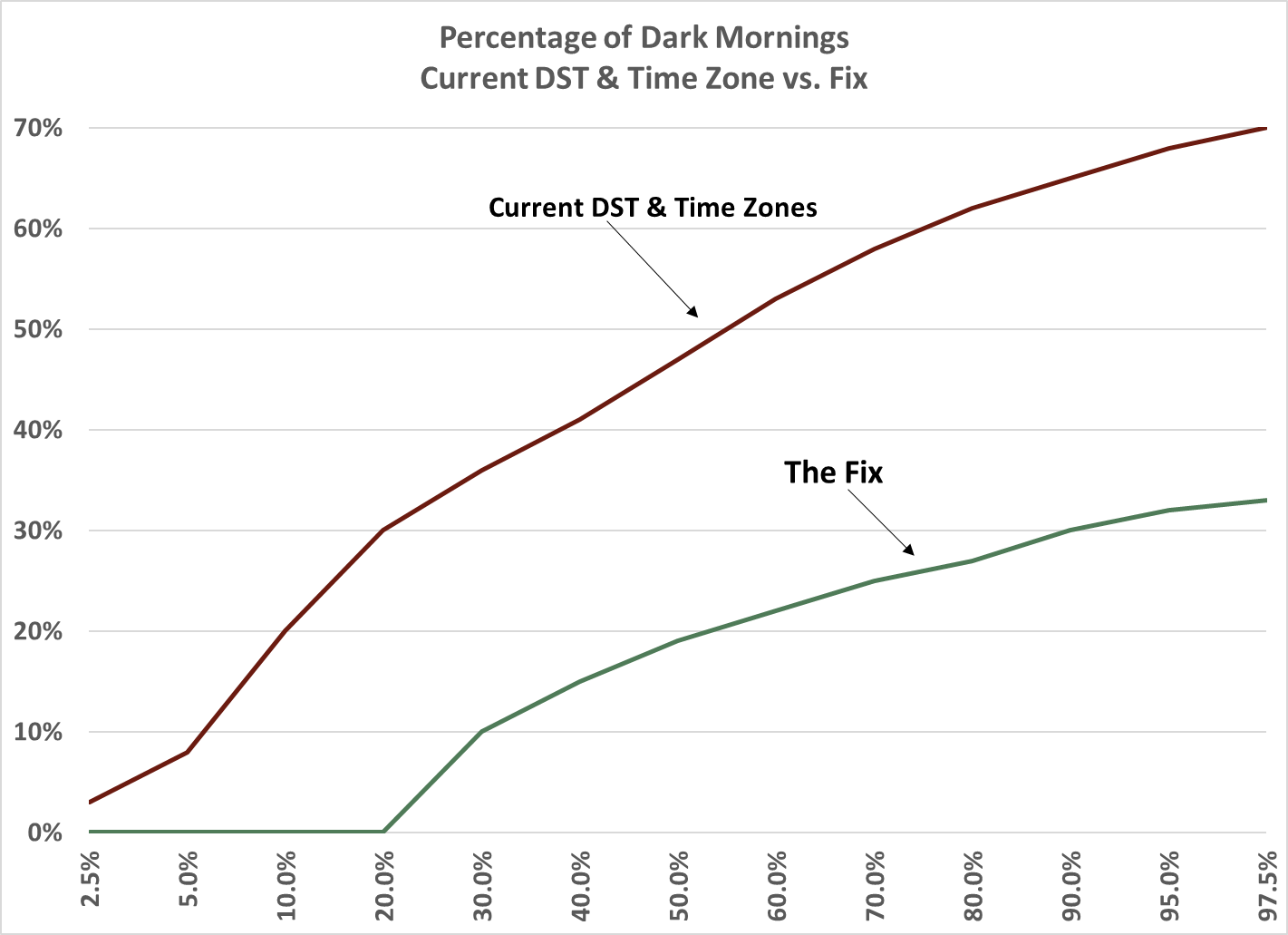
Daylight Saving Is a Trap
Daylight Saving Time Is the Worst
Most countries don’t observe daylight saving time
Google Scholar: Medical Group Position Statements on Daylight Saving Time
Save Standard Time
Google Scholar: Topic, Adverse DST Effects For Adolescents
Kids on way to school endangered by morning darkness
School Bus Stops: Waiting in the Dark
DST Analysis
Why daylight saving time may be bad for your brain and health Headwinds now in precisely the opposite direction. Senate (S.582), Congress (H.R.139), and Executive branch pressing to make daylight saving time the new, permanent time in the United States.
April 2025, Senate testimony was received from Neurologist Karin Johnson and golfing representative, Jay Karen.
How permanent standard time could save lives, explained by a sleep expert
How daylight saving time poses a host of health concerns, according to a neurologist
Daylight Saving Time and Your Health Plus, Steps to Saving Zzz's
Breast cancer risk higher in western parts of time zones
New York Tech: Five DST Looks To Reimagine Our Clock-Changing Habits
Digital Journal: Surprise in Cheboygan, a DST that Increases Morning Sunlight
Andy Woodruff: Where to hate daylight saving time and where to love it
Bloomberg: Where Mornings Would Get Darker Under Permanent Daylight Saving Time
Washington Post: Brighter winter evenings would come at the expense of darker mornings.
Download excel spreadsheet for delays and percentage of dark mornings for all counties in the continental United States
Download NOAA Sunrise.xls Spreadsheet
With cartography, programming, publicly available databases, techniques mentioned in spreadsheet notes and links, the above was created. It is intended to contribute to the discussion. Do not construe any of this as medical advice. For that, consult a healthcare professional. I am not a healthcare professional.
Creative commons license CC BY. Courtesy of Ike Jeanes. Developed by DSTmap.com.
Egregious Time Zones
A time-zone fix is imperative. Eastern and Central Time zones have massively shifted westward since they were initially drawn in 1883 — about 378 miles from an appropriate point. Yet, as the Bureau of Transportation Statistics reports, in the past 20 years, only 15 counties have changed. These 378 miles are not pulled from thin air. At the median latitude for US counties (38.3°), each minute of delay in a time zone translates to 13.5 miles. At a 58-minute delay, the time zone is 28 minutes longer than the appropriate 30-minute maximum. Thus, the 378 miles [= 28*13.5]. Of the 900 inappropriate time-zone counties, half of these counties (yes, 450 counties) are currently more than 100 miles further westward than their time zone's appropriate upper limit. This graph and table, as well as the spreadsheet, show the details.
| Percentile | Miles |
|---|---|
| 1% | 350 |
| 2% | 300 |
| 5% | 250 |
| 13% | 200 |
| 27% | 150 |
| Half 50% | 100 |
| 75% | 50 |
| 88% | 25 |
Repair Your Local Time Zone & See the Change
Now, move your cursor over this interactive map to consider a time-zone fix. The first column in the Table below is the same as in the first map. However, when a time zone is repaired, results are shown separately in black in a second column. This second column shows a fixed time zone. It is empty when no change occurs. At your cursor, in each second column section, the top right percentage reveals the best option; lower left, the worst option. The repair produces four pure one-hour, 15-degrees-of-longitude, time zones (EST, CST, MST, PST) with solar delays falling within a ±30 minute range. The black time-zone boundary lines are consistent with Coordinated Universal Time (UTC) time zones that we now use. Eastern time begins at longitude -67.5°; Central, at -82.5°; Mountain, at -97.5°; and Pacific, at -112.5°. Positioning time zones in this orderly fashion results in the highly favorable outcomes shown, when appropriate, at your cursor and in the second column of the map Table. Let your cursor travel along the three black boundary lines. While you will encounter some urban centers that require special consideration, it is surprising how many low population counties exist along these routes. To eliminate high delays, 479 counties in the Eastern time zone, 370 in the Central, and 47 in the Mountain need to change. In this group of counties, when, instead of sticking with the Current DST, we repair time zones and select either permanent standard time or a Memorial to Labor Day DST, we go from an average 64% of sunrises after 7:00 AM to 4%. On average, our latest sunrise goes from 8:04 AM to 6:54 AM. By these DST and time zone changes, we reliably start our winter mornings with adequate sunlight. In almost 900 US counties, we did not and could not do this before, because we were locked into an inappropriate DST and inappropriate time zones.Delay Measures Being Out of Sync, Particularly the 30 Minute Delay
Delayed sunrises reflect the influence of location. Any delay exceeding 30 minutes (roughly 58% dark mornings with the current DST) indicates a corrupted time zone. Overly dark winter mornings in the United States are entirely caused by unnatural time zones, primarily in the Midwest (and points directly south of it), and by excessively long DSTs. The interactive maps here show that we tend to wrongly attribute late sunrises in much of the northern half of the U.S. to northerly position when, in fact, the late sunrises are caused by inappropriate time zones and long DSTs.| County | State | Delay | Time Zone Miles From Appropriate 30 Minute Delay |
|
| 1 | Presidio | TX | 58 | 372 |
| 2 | Ontonagon | MI | 57 | 368 |
| 3 | Divide | ND | 54 | 323 |
| 4 | Cimarron | OK | 50 | 271 |
| 5 | Vermillion | IN | 50 | 268 |
| 6 | Morton | KS | 47 | 232 |
| 7 | Canyon | ID | 47 | 226 |
| 8 | Meade | KY | 45 | 201 |
| 9 | Hayes | NE | 44 | 192 |
| 10 | Mellette | SD | 43 | 176 |
| 11 | Dade | GA | 42 | 162 |
| 12 | Hamilton | TN | 41 | 144 |
| 13 | Liberty | FL | 40 | 129 |
| 14 | Preble | OH | 39 | 116 |
| 15 | La Paz | AZ | 38 | 106 |
| 16 | Cherokee | NC | 36 | 84 |
| 17 | Beaver | UT | 34 | 51 |
| 18 | Beaverhead | MT | 33 | 43 |
| 19 | Oconee | SC | 32 | 33 |
| 20 | City of Norton | VA | 30 | 7 |
Map Side-by-Side Comparison, Before & After
In 15-degrees-of-longitude, symmetric one-hour time zones, delays are limited to a ±30 minute range. In practice, US time zones are now profoundly lopsided. They strongly favor the western edge. That is why they are prone to producing health and economic problems. The "After" shows that throughout the United States, up to the Canadian border, you can have ample winter early morning sunlight for appropriate circadian entrainment. As in the previous interactive map showing time-zone repair, the first column in this map, when hovering, indicates conditions before the time-zone fix. The second column (when it appears) indicates conditions after the time-zone fix. The "After" map at the right shows the time zone fix. When we also go a step further and employ either permanent standard time or a Memorial to Labor Day DST, the five new bands of map colors respectively hover around 0%, 12%, 20%, 24%, and 29% of days having early morning darkness, typically peaking at 21%, 25%, 29%, 33%, and 37%. Even the new dark "After" map colors are a cure. With the DST/time-zone fix, they show only modest winter morning darkness. The fix returns us to approximately natural time. US Personal Income and stellar academic performance and key health categories have flourished at these percentages of darkness.Latest Sunrises vs. Permanent DST
Among the prior five DST options shown in the map tables, you can precisely see latest sunrise at your location. In 5-minute steps, latest sunrises are condensed in this graph and table. Percentages indicate proportion of counties experiencing latest indicated sunrise times. Widely rejected, "No country is currently on year-round daylight saving time."
| Latest Winter Sunrises Vastly Later with Permanent DST | |||||||||
|---|---|---|---|---|---|---|---|---|---|
| Percentile: | 2.5% | 10% | 25% | 50% | 75% | 90% | 97.5% | Average | Waste |
| Permanent DST | 7:55 | 8:05 | 8:20 | 8:35 | 8:50 | 9:05 | 9:20 | 8:35 | 1:17 |
| Current DST & Time Zones | 7:05 | 7:20 | 7:30 | 7:45 | 8:00 | 8:10 | 8:20 | 7:45 | 0:27 |
| Permanent Standard Time | 6:55 | 7:05 | 7:20 | 7:35 | 7:50 | 8:05 | 8:20 | 7:35 | 0:17 |
| Permanent Standard Time & Fixed Time Zones | 6:35 | 6:45 | 7:00 | 7:20 | 7:35 | 7:45 | 8:00 | 7:17 | 0:00 |
For the Nation, A Common Experience
In their unadulterated state, without DSTs and improper time zones, dark mornings by natural means are absolutely capped at a 37% maximum for all counties in the continental United States. In a vastly different fashion, most of us are now stuck in long seasons of artificial, human-created morning darkness. In the United States, as evidenced by the red curve, we now are living in widely different levels of darkness. These red-curve locations have disproportionately more dark mornings than conditions represented by the other curves. Had we chosen to live in substantially natural time, all of us would experience roughly similar days at a median 19% dark mornings. But now, as a nation we do not have this basic common experience. The spread between us is artificial, unnatural, and large. [Spreadsheet notes: This graph is from the spreadsheet and based on above formulas and a prior graph.]
[Spreadsheet notes: This graph is from the spreadsheet and based on above formulas and a prior graph.]
AI Shows Summertime-Only DST Clock Change To Be 5.3x More Desirable
In addition to time zones, we are well-served by considering the differences between short and long DSTs. With rare exceptions, none of us have lived with short DSTs. Their influence is entirely different from long DSTs. Quoting ChatGPT we find that:Based on a quantitative analysis and broader understanding of human circadian rhythm and societal patterns, it is reasonable to argue that a short DST beginning on May 20 would be significantly less objectionable — by a factor of around 5.3 — than a traditional long DST starting in March. Here's why: Quantitative Case: Sunrise Shifts & Longitude Translation 1. Sunrise change over 30 days: Short DST (May 20): 8-minute earlier sunrise over 30 days.
Long DST (March 10): 42.7-minute earlier sunrise over 30 days.
This means sunrise times are much more stable around the May 20 period. 2. Translation to geographic equivalence: 1 minute of sunrise change ≈ 13.5 miles of longitudinal shift.
So:
Short DST = 108 miles
Long DST = 576 miles
That’s a 5.3x difference — suggesting that the long DST shift is equivalent to a forced "geographic relocation" that's over 5 times as jarring. Biological & Circadian Implications Circadian rhythms are highly sensitive to light, especially morning light.
The earlier in the year DST starts, the less daylight is available in the morning, making the clock change biologically harder:
March 10 DST robs people of already scarce morning light.
May 20 DST happens after the spring daylight increase, so there's less disruption to sleep-wake cycles.
Sleep researchers widely criticize early DST for exactly this reason. Social and Practical Considerations In March, people are still adjusting to post-winter fatigue, and mornings are dark.
In late May:
Days are longer, weather is better, and outdoor activity increases.
The DST switch aligns more naturally with societal rhythms (e.g., school nearing end, summer beginning).
This would increase acceptance and decrease complaints, making it less controversial. ChatGPT Conclusion
Shifting to a short DST beginning on May 20 would likely be around 5.3 times less objectionable than a traditional early March DST, both in terms of biological impact and public sentiment. The more stable sunrise times, reduced circadian disruption, and greater societal alignment all support this.
Summertime-Only
A Celebration of Summer
A Memorial to Labor Day DST
The Unofficial Start and End of Summer
Prior to the 1966 Uniform Time Act, Iowa and Minnesota practiced a Memorial to Labor Day DST. The Congressional Record shows that as late as 1985, the American Farm Bureau policy was, "We support legislation limiting daylight saving time to the period between Memorial Day and Labor Day." And, "We continue to support the right of a state to exempt itself from daylight saving time." The old Farm Bureau policy was wise. As the Kentucky Farm Bureau wrote in 1971, the Memorial to Labor Day DST is a reasonable way to alleviate problems created by daylight saving time. As a compromise, it will not satisfy everyone but it may go a long way toward resolving conflict.
Let’s look at median western-edge times prior to applying a long or short DST. In the following table, “Proximity” is sunrise relative to a 7:00 AM wake-up.
For a sunrise to stay clear of a 7:00 AM wake-up, proximity at the start of the DST must exceed 60 minutes. Given this, and with improper time zones, a DST should never begin (or be active) prior to April 28.
A Memorial to Labor Day DST is safely wide of this mark. Its proximity is at 1:45 hours. Sunrise is at 5:51 AM. Mornings are long, 7:11 hours. By this time of the year, morning sunlight is changing very slowly. It will take 32 days for sunrise to occur 8 minutes earlier. This DST provides plenty of winter early morning sunlight for circadian entrainment. To initiate a DST on May 20 will reduce morning hours by a modest 14%. Many of those hours occur when we are fast asleep.
| # Day | Date | Event | Sunrise | Morning Hours | DST % of Hours | Proximity |
|---|---|---|---|---|---|---|
| 1 | Jan 1 | New Year | 7:46 AM | 4:46 | 21% | -0:46 |
| 69 | Mar 10 | Current DST Start | 6:48 AM | 5:51 | 17% | 0:11 |
| 140 | May 20 | Memorial Day | 5:14 AM | 7:11 | 14% | 1:45 |
| 172 | Jun 21 | Longest Morning | 5:06 AM | 7:25 | 13% | 1:53 |
| 252 | Sep 9 | Labor Day | 6:06 AM | 6:20 | 16% | 0:53 |
| 308 | Nov 4 | Current DST End | 6:58 AM | 5:15 | 19% | 0:02 |
[The above is based on NOAA spreadsheet, where a median latitude is employed at a conventional western edge
border (latitude 38.3°, longitude -82.5°, time zone -5, delay 30 minutes, local solar times prior to DST adjustments)].
While we sleep, it makes good use of some of the abundant May 20th very early morning hours. We still have 6:11 morning hours of sunlight remaining after one hour is taken away for a Memorial to Labor Day DST. Similarly, after exiting it in September, 6:20 hours of morning sunlight remain.
With an eye toward practicality, it begins a week before and ends the week after heavy holiday transportation demands. Perhaps paramount for many, it happily blends with the tradition of Memorial Day being the unofficial start of summer and Labor Day being the unofficial end of summer border (latitude 38.3°, longitude -82.5°, time zone -5, delay 30 minutes, local solar times prior to DST adjustments)].
— a bona fide summertime-only DST. An opportunity to catch the wave at the instant of high retail sales. High resilience/low death rates. A cresting of sunlight hours. A celebration of summer.
By contrast, the current DST March 10 start date fails on all points. Sunrise, late. Morning sunlight hours, short. Morning sunlight, already increasing rapidly. Proximity to sleep hours, harmful. High seasonal mortality. No social buoyancy.
Because of the 1966 Uniform Time Act and long DSTs, we never experienced in our lifetimes the natural unfolding of spring. With the prior gradual increase in sunlight, we safely and pleasurably could adapt over a period of about 55 days to 60-minute natural increases in morning sunlight. Instead, long DSTs gave us a three-part spring cycle:
- adjust (adapt to a natural 60-minute increase in morning sunlight over about 55 days)
- reverse (in one day take away those 60 minutes of morning sunlight)
- adjust again (try to recover)
The DST Fiasco. A Failure to Crop the Wings.
The current DST is a misshapen bird. Its body (June through August) does the work. Its wings (March through April and September through October) do the damage. Current DST is active for two-thirds of a year. Half of that time — one-third of a year — is spent in destruction. "Abolish DST?" … Or just, "Crop the Wings?" Eastern positions within a time zone increase seasonal morning sunlight. Exacerbated by improper time zones, western positions decrease it. For example, Terre Haute in Vigo County, IN is about 260 miles further westward than is appropriate for its time zone. When, on the map, you move your cursor due west from Washington, DC to Vigo (both are nearly at the same latitude), you go from 38% of early mornings being dark in Washington to 70% being dark in Vigo. Washington and cities on the East Coast typically have far fewer dark mornings than experienced on the western edges of time zones. As for a fix, it is generally unknown that when its time zone is repaired to more closely approximate natural time, Vigo will have only 20% dark mornings – far better than the vast majority of counties on the East Coast, better than the 24% in Santa Barbara, CA, and about the same as at Harvard University and MIT. Similarly, it is generally unknown that when, instead of the current DST, permanent standard time or a short Memorial to Labor Day DST is also employed in Vigo, only 13% of mornings will be dark. Only three counties on the East Coast can now claim this honor. For Vigo to get there requires a two-step process: 1) repair time zone, and 2) trim DST’s wings to a short period. The three interactive maps on this page make this clear. Without the wings and without improper time zones, there is no inappropriate increase in morning darkness. As shown in the graph, quickly rising morning temperatures in Vigo come between 7:00 AM and 10:00 AM, with peaks occurring by about 4:00 PM. In Vigo, the current DST starts on March 10 with a typical three temperature sequence of: 35°, 41°, and 49°. The cool/cold wings shatter the myth that the current DST is predominantly a summertime experience.
A corrupted time zone or a DST of any length makes early mornings darker and colder. When DST-induced darkness and coolness are confined to counteracting a short period that already has abundant early morning sunlight and high temperature, the DST appears to be passably harmless.
But when, as with the current DST, this darkness and coolness is widely spread over many already cool and dark months, the percentage of dark and cold mornings escalate. The wings do the damage.
The Memorial to Labor Day DST has no wings. At 7:00 AM, it begins and ends at 60° in Vigo.
By contrast, the current DST has long wings. It contains 71 more Spring days (March to May) and 55 more Fall days (September to November) than the summertime-only Memorial to Labor Day DST.
Why have the wings?? They are useless. At a total 126 days, they are even longer than the 113-day summertime-only DST.
These 126 additional days of Daylight Saving Time raise obvious warning flags, given that they all occur during school months when early morning cognition and school bus safety are issues. By skirting harmful aspects of long DSTs and by having a low percentage of sunrises after 7:00 AM, a Memorial to Labor Day DST is a winner, as is permanent standard time.
[Spreadsheet notes: Temperature, Vigo County, IN. US Hourly Climate Normals (2006-2020).]
As shown in the graph, quickly rising morning temperatures in Vigo come between 7:00 AM and 10:00 AM, with peaks occurring by about 4:00 PM. In Vigo, the current DST starts on March 10 with a typical three temperature sequence of: 35°, 41°, and 49°. The cool/cold wings shatter the myth that the current DST is predominantly a summertime experience.
A corrupted time zone or a DST of any length makes early mornings darker and colder. When DST-induced darkness and coolness are confined to counteracting a short period that already has abundant early morning sunlight and high temperature, the DST appears to be passably harmless.
But when, as with the current DST, this darkness and coolness is widely spread over many already cool and dark months, the percentage of dark and cold mornings escalate. The wings do the damage.
The Memorial to Labor Day DST has no wings. At 7:00 AM, it begins and ends at 60° in Vigo.
By contrast, the current DST has long wings. It contains 71 more Spring days (March to May) and 55 more Fall days (September to November) than the summertime-only Memorial to Labor Day DST.
Why have the wings?? They are useless. At a total 126 days, they are even longer than the 113-day summertime-only DST.
These 126 additional days of Daylight Saving Time raise obvious warning flags, given that they all occur during school months when early morning cognition and school bus safety are issues. By skirting harmful aspects of long DSTs and by having a low percentage of sunrises after 7:00 AM, a Memorial to Labor Day DST is a winner, as is permanent standard time.
[Spreadsheet notes: Temperature, Vigo County, IN. US Hourly Climate Normals (2006-2020).]
DST's Pitiful Wings, Waste & Destruction: Oct, Mar, Apr, Sep.
The damage done by the current DST is done at the wings. We need to focus on that portion of the DST. It has no health or economic benefit. Glowing claims of the current DST's economic advantage are routinely made. Stats don't match. The frequent claim that the current DST drives retail sales is misleading. At best, the influence is small. The winged months of October, March, April, and September are some of the worst retail months … a 122-day DST waste. As for a possible countercyclical advantage, the retail oscillation that might prove useful is to begin a DST at the rare peak on or about May 20. Yes, there are seasonal patterns, but month to month deviations are commonly small without a pattern sufficient to claim that the current DST improved the economy. We should not be surprised. In the fourth quarter, retail constituted a mere 6.3 percent of GDP.Tail now wags dog.

| Ranked Retail Sales Relative to Average Month | ||||
|---|---|---|---|---|
| Month | Rank | 1993-2019 | DST #3, 1993-2006 | DST #4, 2007-2019 |
| Dec | 1 | 24.5% | 28.4% | 19.9% |
| Nov | 2 | 3.6% | 3.7% | 3.5% |
| May | 3 | 2.7% | 1.8% | 3.7% |
| Aug | 4 | 1.5% | 1.2% | 1.8% |
| Jun | 5 | -0.6% | -1.1% | 0.0% |
| Oct | 6 | -0.8% | -0.8% | -1.0% |
| Jul | 7 | -1.0% | -1.7% | -0.1% |
| Mar | 8 | -1.8% | -3.3% | -1.0% |
| Apr | 9 | -2.9% | -3.2% | -2.6% |
| Sep | 10 | -4.5% | -4.4% | -4.6% |
| Jan | 11 | -10.3% | -11.0% | -9.5% |
| Feb | 12 | -12.5% | -13.2% | -11.5% |
| . | ||||
| Oct, Mar, Apr, Sep | -2.5% | -2.9% | -2.3% | |
| Aug, Jun, Jul | 0.0% | -0.5% | 0.6% | |
Retail sales. Tip of iceberg.
Most economic activity occurs entirely outside the retail sector. 90% of nonfarm employees produce 94% of GDP. Much productive work occurs during morning hours. Via circadian channels, appropriate exposure to early morning sunlight influences health, alertness, mood, and cognitive abilities. A failure to take advantage of morning alertness is a foregone opportunity. To compromise morning hours of sunlight by indiscriminately taking one hour from them, and thereby increasing morning darkness, comes at a large expense to the economy. Alertness and quality of decision-making during these hours are crucial for economic success.
 [Spreadsheet notes: 3,093 counties, current DST and time zones. Based on Centers for Disease Control and Prevention Pre-COVID database,
[Spreadsheet notes: 3,093 counties, current DST and time zones. Based on Centers for Disease Control and Prevention Pre-COVID database,
Social Vulnerability Index 2018. Total_Personal_Income= Per_Capita_Personal_Income *Population. Data sorted to Percent_Days. Index= Centered rolling
200-point median/ column_median* 100. Index smoothed on 30-point centered moving average. Not required here but used elsewhere: Proper Delay= MOD(ABS(longitude) *4+30,60)-30.]
— perhaps nice places avoided because their mornings were made less attractive than in the majority of the nation. It is striking when studying the U.S. News & World Report’s 2024 Healthiest Communities list (with a metric that equally values equity, vitality, and overall rank) how many nice, unrecognized midwestern counties percolate to the top.
Entire regions are harmed by the fiction that manipulating DST and time zones far from their natural conditions is beneficial when, in fact, the data shows that the economic impact is devastating.
It is Not Only Economics. It is Life Expectancy.
The following is definitive. A tight link exists between delay (as in the Western Edge Effect) and longevity. The dark mornings that come with long DSTs and improper time zones pack a wallop. The dotted background illustrates high variability when using only modest smoothing. Notwithstanding, we can make a solid analysis because we know: 1) delays for each county, 2) life expectancies for each county, and 3) we are consistently dealing with a large 900-county group, equivalent to improper time-zone group size. [Spreadsheet notes: Life expectancy estimates 2000-2019, both sexes. High accuracy life-expectancy data to
[Spreadsheet notes: Life expectancy estimates 2000-2019, both sexes. High accuracy life-expectancy data to fraction of a year. To reduce confounding elements limited data to white race.]
Median performance occurs at 15-delay and 17-delay: 77.7 years.
Worst performance occurs at 37-delay: 77.1 years, solidly at the center of the corrupted time-zone group.
The difference between maximum and minimum: 1.24 years, 65.5 million person-years.
The difference between median and improper time zone group: 0.65 years, 34.6 million person-years. Again, improper time zones are unnecessary and harmful.
Topics On This Page & Thesis Summary Show the Damage and Opportunity
- First Map
- Egregious Time Zones
- Repair Your Local Time Zone & See the Change
- Delay Measures Being Out of Sync, Particularly the 30 Minute Delay
- Map Side-by-Side Comparison, Before & After
- Latest Sunrises vs. Permanent DST
- For the Nation, A Common Experience
- AI Shows Summertime-Only DST Clock Change To Be 5.3x More Desirable
- Summertime-Only
A Celebration of Summer
A Memorial to Labor Day DST
The Unofficial Start and End of Summer - The DST Fiasco. A Failure to Crop the Wings.
- DST's Pitiful Wings, Waste & Destruction: Oct, Mar, Apr, Sep
- It is Not Only Economics. It is Life Expectancy.
- Topics On This Page & Thesis Summary Show the Damage and Opportunity
- Digging Deeper
- Formulas For Delay & For Estimating Percentage of Dark Mornings
- University Rankings Uncover Underbelly of DST & Time Zones
- The Essential Elements
Top Ranked Health … Payoff for Being in Sync … The 8 Minute Median - Delay & Improper Time Zones Reduce Life Expectancy
- Circadian Impact on Real Estate, Towns, Cities, and Counties
Dark Mornings Reduce Your Home's Value - Flipping the Time-Zone/DST Incline … Low Delays Grow Population
- Best Cities Through Circadian Eyes
- Property Crime Linked to Delay
- "Western Edge Effect" Meets the 2024 Election
- DST Choices
- What About the Press? Improper Time Zones vs. DST
- Fixing It
- Teenagers
- Bedtime for Night Owl??
- DST and Seasonal Mortality
- Conclusion: New Seasons of Winter Morning Darkness, A Summary of Options
- Links
Reddit user provided this summary:
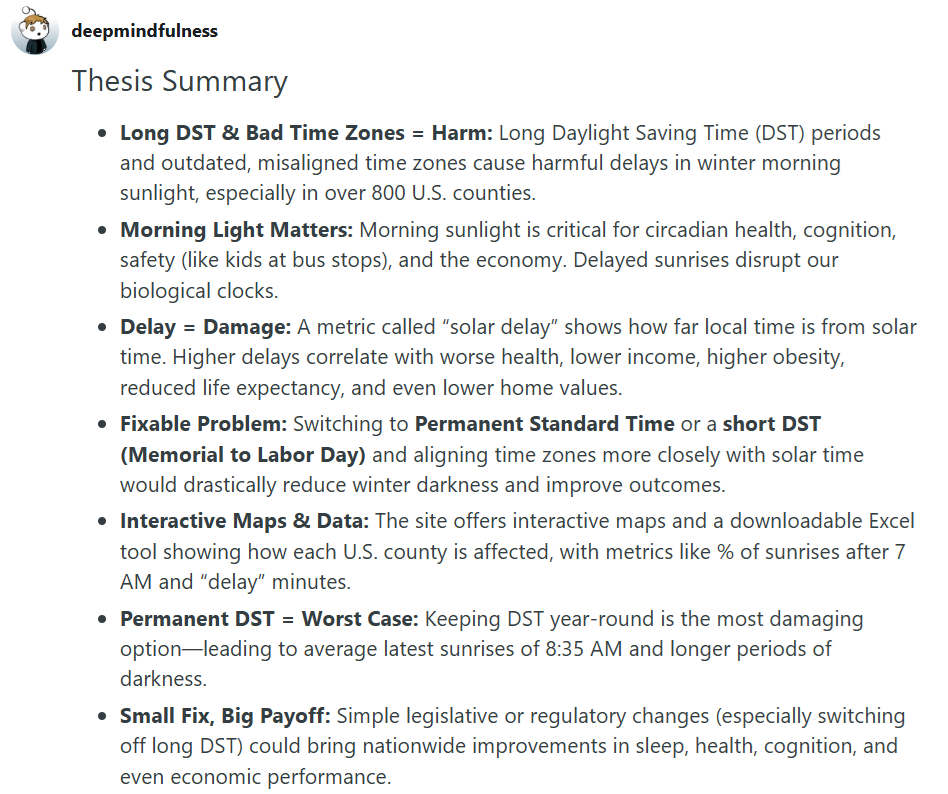

Formulas For Delay & For Estimating Percentage of Dark Mornings
Appropriate time-zone boundaries occur at a 30-minute delay. In a one-hour time zone (60 minutes, with two 30-minute sections), the delay should fall within a ±30 minute range. It frequently does not. As a consequence, we focus on key players: DST and time zone. If you would like to calculate delay or percentage of dark morning trendlines on your own, you can do so.|
In a spreadsheet solar delay as used here equals (ABS(longitude)/15- ABS(time_zone_integer_hours_from_Greenwich)) *60 [Respectively -5, -6, -7, -8 integer hours for EST, CST, MST, PST time zones.] |
|
With the current DST, Percentage of Dark Mornings = 28.84+(0.94955*Solar_delay); Smoothed Data Standard Deviation 2.6; R2=0.977 28.88+(0.94756*Solar_delay); Raw Data Standard Deviation 5.4; R2=0.909 |
|
With a Memorial Day DST or Permanent Standard Time, Percentage of Dark Mornings = 16.98+(0.59967*Solar_delay); Smoothed Data Standard Deviation 2.2; R2=0.959 17.02+(0.59877*Solar_delay); Raw Data Standard Deviation 4.8; R2=0.835 |
| Percentage of Dark Mornings | ||||
|---|---|---|---|---|
| Delay | Current DST | Permanent Standard Time or a Short DST | Difference | Additional Needlessly Dark Mornings |
| 0 | 29% | 17% | 12% | 43 |
| 1 | 30% | 18% | 12% | 45 |
| 2 | 31% | 18% | 13% | 46 |
| 4 | 33% | 19% | 13% | 48 |
| 6 | 35% | 21% | 14% | 51 |
| 8 | 36% | 22% | 15% | 53 |
| 10 | 38% | 23% | 15% | 56 |
| 12 | 40% | 24% | 16% | 59 |
| 14 | 42% | 25% | 17% | 61 |
| 16 | 44% | 27% | 17% | 64 |
| 18 | 46% | 28% | 18% | 66 |
| 20 | 48% | 29% | 19% | 69 |
| 22 | 50% | 30% | 20% | 71 |
| 24 | 52% | 31% | 20% | 74 |
| 26 | 54% | 33% | 21% | 76 |
| 28 | 55% | 34% | 22% | 79 |
| 30 | 57% | 35% | 22% | 81 |
| 35 | 62% | 38% | 24% | 88 |
| 40 | 67% | 41% | 26% | 94 |
| 45 | 72% | 44% | 28% | 101 |
| 50 | 76% | 47% | 29% | 107 |
| 55 | 81% | 50% | 31% | 113 |
University Rankings Uncover Underbelly of DST & Time Zones
U.S. News & World Report’s University Rankings provide a fine opportunity to evaluate low percentage of dark mornings at high-ranked universities. When we compare dark mornings in these microcosms of excellence to the 3,000 US counties, we see vast differences. These premier institutions have far fewer dark mornings than the general population. As to a university's purpose, cognition and maturation are central to the enterprise. Under circadian influence, maturation of the brain will continue until about age 25. With an eye toward determining levels of morning sunlight appropriate for cognition, university rankings are important to study. They seem to indicate that fewer dark mornings contribute to academic success. In the graph, we see a huge spread between the Top 10 universities and the common-case 3,000 counties. The Table shows that the current DST and its time zones, at the median, produce 47% dark mornings. A median percentage of darkness at 23% or less appears to be conducive to outstanding performance. A median higher than 30% seems to impede excellence.

| Percentile: | 2.5% | 5.0% | 10.0% | 20.0% | 30.0% | 40.0% | Median 50.0 % | 60.0% | 70.0% | 80.0% | 90.0% | 95.0% | 97.5% |
|---|---|---|---|---|---|---|---|---|---|---|---|---|---|
| Percentage of Dark Mornings | |||||||||||||
| Time Zone/DST Fix | 0% | 0% | 0% | 0% | 10% | 15% | 19% | 22% | 25% | 28% | 31% | 33% | 34% |
| Top 10 | 9% | 9% | 9% | 10% | 21% | 23% | 23% | 28% | 30% | 37% | 38% | 42% | 42% |
| Top 25 | 9% | 10% | 13% | 21% | 23% | 24% | 30% | 37% | 38% | 46% | 50% | 60% | 66% |
| Top 100 | 9% | 10% | 16% | 23% | 23% | 28% | 30% | 38% | 43% | 50% | 60% | 65% | 67% |
| All Counties, % Dark | 3% | 8% | 20% | 30% | 36% | 41% | 47% | 53% | 58% | 62% | 65% | 68% | 70% |
| Minutes Delay | |||||||||||||
| Time Zone/DST Fix | -29 | -27 | -25 | -20 | -14 | -7 | 0 | 6 | 12 | 18 | 25 | 27 | 29 |
| Top 10 | -16 | -16 | -16 | -15 | -10 | -8 | -4 | -1 | 2 | 7 | 9 | 12 | 14 |
| Top 25 | -16 | -15 | -14 | -10 | -8 | -5 | 1 | 7 | 9 | 16 | 21 | 32 | 39 |
| Top 100 | -16 | -15 | -11 | -8 | -4 | 0 | 2 | 8 | 13 | 22 | 32 | 38 | 44 |
| All Counties, Delay | -16 | -13 | -8 | -1 | 5 | 11 | 18 | 24 | 30 | 35 | 40 | 44 | 47 |
dark mornings using already established delay to percent relationships. Use Excel percentile formula to produce graph and table. Data related to the fix come directly from original
computer program. Note: In a perfectly symmetric ±30 time zone, median delay is zero. Median delay at "Time Zone/DST Fix" comes close to this.]
The Essential Elements
Top Ranked Health … Payoff for Being in Sync … The 8 Minute Median
The influence of delay and morning sunlight may be subliminal and seemingly of slight influence, but that initial impression is misleading. Just as rankings uncover minutes of delay at universities, ranking health categories can also uncover median delays. In diverse health classifications, top performance is widespread at low median delays and few dark mornings.
Being in sync matters. Morning sunlight is a key to health. First thing in the morning it resets body clocks. This is done daily. By comparison to artificial light, sunlight is especially effective because it is many times more potent. Dark mornings corrupt the resets. Consistent with this discussion, Google's AI points out: "Get bright light in the morning to feel more alert during the day." … "The sleep-wake cycle is incredibly important for overall health and well-being."
Delay rules. With this simple handle, we can see the beneficial impact of morning sunlight. Being out of sync suppresses top performance. In this race, low delays are winners; high delays, losers. Like the Western Edge Effect, the lower the delay at your location, the more beneficial the impact. Quickly put: You get best circadian performance the closer you are to being in sync, which is to say, your location has a low delay.
Beneficial circadian impact from the sun's light/dark cycle is surprisingly easy to spot. All you need to do is to look at median delay in a ranked category. In numerous categories, the following table tells what otherwise would be a complex story.
Keep an eye on delays 8 or lower. Superior performance (Top 250 and lower) has a low median delay and increased morning sunlight, e.g., a delay that is 8 or lower as highlighted in the table.
The emphasis is on the Top 250 (the top 8%). It provides a high-performance focus with an adequately large sample size. The further away delay is from this point, the weaker its grip. It is the beneficial influence of being in sync (low delays) that carries the weight. Using the median at Top 250 as an example: In a group of 250 counties, 125 counties are beneath the median; 125, above it.
The delay segments that underlay these values are shown in the second half of the table to answer a natural curiosity about data that creates the rankings.
In each of the categories, medians based on various portions of 3,000 data points carry considerable weight. Where you see only one number here, you do not see the many that support it. Most of the individual numbers in this table are backed by circadian features of 250 or more counties. The footprint of the light/dark cycle is large and, at the Top 250 level, often deep.
Count yourself lucky if you live in a location with a low delay. Only 1/3 of counties now have a delay of 8 or lower. Unless there is change in DST and time zones, you often would need to live in one of these counties to get median 8-delay benefits. Effectively, by way of improper time zones and long DSTs, forced geographic relocations have already resulted in many counties being less healthy than they normally would have been.
This table tells the story. In each health category, it shows median delays which now exist. By gradation, median delays in the table illustrate requirements for being suitably in sync at a range of rankings. As shown, requirements differ according to rank and category.
| Each Health Category Shown in Rank Order, Top 50 to Top 3000. Corresponding Median Delays Shown at Each Level. | ||||||||||||||||||
|---|---|---|---|---|---|---|---|---|---|---|---|---|---|---|---|---|---|---|
| Obesity | Diabetes | Activity LPA | Income | Smoking | Heart | Stroke | Disability | Average Combo-8 | Mobility | General Health | Kidney | Cognition | No Diploma | Poverty | Depres- sion | Cancer | RND | |
| Top 50 | 7 | 3 | 6 | 5 | 9 | 8 | 8 | 8 | 6.7 | 9 | 8 | 10 | 10 | 9 | 11 | 27 | 31 | 11 |
| Top 100 | 4 | 1 | 8 | 7 | 8 | 8 | 8 | 8 | 6.4 | 8 | 8 | 4 | 10 | 13 | 12 | 27 | 31 | 14 |
| Top 250 | 3 | 5 | 8 | 8 | 8 | 8 | 8 | 8 | 7.0 | 9 | 9 | 9 | 12 | 14 | 14 | 25 | 15 | 18 |
| Top 500 | 7 | 10 | 9 | 9 | 9 | 10 | 11 | 11 | 9.4 | 11 | 12 | 13 | 13 | 14 | 15 | 20 | 20 | 19 |
| Top 750 | 8 | 11 | 11 | 12 | 12 | 11 | 13 | 12 | 11.2 | 12 | 13 | 14 | 14 | 15 | 15 | 20 | 17 | 18 |
| Mediocre Top 1500 | 13 | 14 | 15 | 15 | 15 | 14 | 15 | 17 | 14.8 | 16 | 15 | 14 | 17 | 16 | 17 | 16 | 16 | 18 |
| Top 3000 | 17 | 17 | 17 | 17 | 17 | 17 | 17 | 17 | 17.0 | 17 | 17 | 17 | 17 | 17 | 17 | 17 | 17 | 18 |
| Ratio | 2.4 | 1.7 | 2.0 | 1.9 | 1.9 | 1.8 | 1.5 | 1.5 | 1.8 | 1.5 | 1.4 | 1.3 | 1.4 | 1.2 | 1.1 | 0.9 | 0.9 | 0.9 |
Segments |
||||||||||||||||||
| Top 50 | 7 | 3 | 6 | 5 | 9 | 8 | 8 | 8 | 6.7 | 9 | 8 | 10 | 10 | 9 | 11 | 27 | 31 | 11 |
| Top 50 to 100 | 1 | 0 | 8 | 7 | 8 | 6 | 7 | 7 | 5.5 | 7 | 11 | -1 | 14 | 21 | 14 | 30 | 27 | 15 |
| Top 100 to 250 | 2 | 8 | 8 | 8 | 7 | 8 | 8 | 9 | 7.3 | 10 | 10 | 12 | 15 | 14 | 17 | 22 | 9 | 20 |
| Top 250 to 500 | 12 | 14 | 11 | 12 | 12 | 13 | 17 | 16 | 13.3 | 17 | 15 | 19 | 13 | 15 | 17 | 16 | 23 | 19 |
| Top 500 to 750 | 13 | 15 | 17 | 22 | 20 | 16 | 18 | 17 | 17.3 | 14 | 18 | 15 | 15 | 16 | 16 | 19 | 13 | 17 |
| Mediocre Top 750 to 1500 | 19 | 17 | 21 | 18 | 19 | 18 | 17 | 22 | 18.9 | 21 | 16 | 14 | 21 | 18 | 18 | 12 | 16 | 19 |
| Top 1500 to 3000 | 22 | 21 | 19 | 20 | 19 | 20 | 20 | 17 | 19.7 | 19 | 20 | 21 | 17 | 18 | 19 | 17 | 18 | 17 |
 The method is simple, sensitive, and strong. Note that at Top 50, 100, and 250 Diabetes at medians of 5 or lower consistently has a strong circadian response.
By ratio, obesity is the highest ranked category for beneficial response from being in sync with the sun's light/dark cycle. Whether you look to sources on the web, on YouTube, or in scholarly literature, you will also find a potent link between obesity and circadian rhythms.
For example, we see in the graph that with very low percentages of obesity, delays are low. But delays sharply increase when this percentage increases, as does the reduced morning sunlight that comes with this progression. Instinctively, it is surprising that a component like delay would have such a formidable influence on body weight. Along these lines, studies show morning sunlight does influence weight gain.
Ratios in the table also illustrate relative strength in other categories. With the table you can get an intuitive feel for which health components tend to be most influenced by morning sunlight. For example, in the table we see median delay strongly acting on per capita personal income (high ratio) and to a lesser extent (low ratios) on no high school diploma and poverty, which are better observed elsewhere. Cognition at an intermediate ratio of 1.4 brings to mind the previously discussed college rankings.
It is especially interesting that leisure-time physical activity (LPA), the second highest ratio, shows such a strong pattern of low median delays. This flies in the face of the contention that DST increases physical activity by creating an extra hour of afternoon sunlight. To the contrary, the table shows that low delays and more morning sunlight increase the amount of leisure-time physical activity! Along the same lines, the literature routinely indicates that claimed exercise benefits from DST are at best modest and not universally supported.
The method is simple, sensitive, and strong. Note that at Top 50, 100, and 250 Diabetes at medians of 5 or lower consistently has a strong circadian response.
By ratio, obesity is the highest ranked category for beneficial response from being in sync with the sun's light/dark cycle. Whether you look to sources on the web, on YouTube, or in scholarly literature, you will also find a potent link between obesity and circadian rhythms.
For example, we see in the graph that with very low percentages of obesity, delays are low. But delays sharply increase when this percentage increases, as does the reduced morning sunlight that comes with this progression. Instinctively, it is surprising that a component like delay would have such a formidable influence on body weight. Along these lines, studies show morning sunlight does influence weight gain.
Ratios in the table also illustrate relative strength in other categories. With the table you can get an intuitive feel for which health components tend to be most influenced by morning sunlight. For example, in the table we see median delay strongly acting on per capita personal income (high ratio) and to a lesser extent (low ratios) on no high school diploma and poverty, which are better observed elsewhere. Cognition at an intermediate ratio of 1.4 brings to mind the previously discussed college rankings.
It is especially interesting that leisure-time physical activity (LPA), the second highest ratio, shows such a strong pattern of low median delays. This flies in the face of the contention that DST increases physical activity by creating an extra hour of afternoon sunlight. To the contrary, the table shows that low delays and more morning sunlight increase the amount of leisure-time physical activity! Along the same lines, the literature routinely indicates that claimed exercise benefits from DST are at best modest and not universally supported.
 High delays come hand in hand with poorer outcomes. From the perspective of health and personal income, long DSTs and improper time zones are a catastrophe.
Top performing ranks have low delays. By living in a low delay location, a person can enjoy benefits in widespread categories. On the other hand, someone who lives in a high-delay area can not enjoy this broad range of opportunity. They are stuck without equal ability to achieve high rank in a wide variety of categories.
As illustrated in the graph, with the current DST and time zones, now only 34% of counties can deliver 8-minute delays. We are hamstrung. Fortunately, with a DST/time-zone fix, 63% of counties can easily deliver 8-minute delays.
If, for a county, your objective in a category is, for example, to perform at the Top 250 level in many categories, you typically would want your county to have a median delay equal to or less than the one shown in the table — an 8 minute median delay and 36% dark mornings seemingly being an adequate objective in many categories.
To get to this point often requires a time-zone/DST fix. You see, delay is caused by your location. Beyond this, major changes in delay and features of the light/dark cycle must come from legislated components, specifically: time zones and DSTs.
High delays come hand in hand with poorer outcomes. From the perspective of health and personal income, long DSTs and improper time zones are a catastrophe.
Top performing ranks have low delays. By living in a low delay location, a person can enjoy benefits in widespread categories. On the other hand, someone who lives in a high-delay area can not enjoy this broad range of opportunity. They are stuck without equal ability to achieve high rank in a wide variety of categories.
As illustrated in the graph, with the current DST and time zones, now only 34% of counties can deliver 8-minute delays. We are hamstrung. Fortunately, with a DST/time-zone fix, 63% of counties can easily deliver 8-minute delays.
If, for a county, your objective in a category is, for example, to perform at the Top 250 level in many categories, you typically would want your county to have a median delay equal to or less than the one shown in the table — an 8 minute median delay and 36% dark mornings seemingly being an adequate objective in many categories.
To get to this point often requires a time-zone/DST fix. You see, delay is caused by your location. Beyond this, major changes in delay and features of the light/dark cycle must come from legislated components, specifically: time zones and DSTs.
Perpetuating DST Wings and Corrupted Time Zones.
For Top Performance Must Dump Them
To perform at a Top 250 level often requires that your location have a delay not higher than 8 or 36% dark mornings. We need to be clear. Low delays like 8 can be required for a Top 250 level of superior performance across many categories, the Combo-8 being just one example of widespread influence.
Yet, with current time zones and DST, two-thirds of all counties are now completely unable!! to get down to the 8-delay or the 36% point, despite Top 250 levels of performance often requiring it. With this, they are more likely to be stuck at lower performance levels indicated in the table.
Perpetuating DST wings and corrupted time zones prevents breaking through the 8-delay, 36%-barrier. Whereas, with the wings and corrupted time zones removed, literally every American has dark mornings capped at a 37% maximum, effectively equal to the current median 8-delay's 36%.
Details aside, being capped at 37% is the safe position. It works. It employs the same data used in the interactive maps. This sea change in many categories provides increased opportunity for a Top 250 level performance for all Americans, not just the lucky few now living at locations with an 8-delay median or lower.
Plain, simple, and crucial. The fine edge of reason is whether to have: More Top 250 Level Performance, or Wings and Corrupted Time Zones.
Delay & Improper Time Zones Reduce Life Expectancy
With tip top life expectancy, we have a delay of 8. With high delays life expectancy is in the dumps, as we again see here, this time via the rankings. The previous table concentrated on delay's impact in health categories. Here we expand the picture to see life expectancy at birth worsening with increasing delays, especially very high delays. The first part of this table uses the same techniques as in the health rankings. Here we drill down into each segment, where we find the meat of the matter. The potency of the full range of life-expectancy delays in this table is consistent with the General Health ratio of 1.4 in the previous ranked health categories. Table values sorted on life expectancy.| Life Expectancy & Delay | ||||||
|---|---|---|---|---|---|---|
| Rank | Median Delay | Segment | Life Expectancy Median | Reduction Per Step | Median Delay | |
| Top 50 | 8 | Top 50 | 83.7 | 8 | ||
| Top 100 | 9 | Top 50 to 100 | 82.5 | 1.3 | 10 | |
| Top 250 | 10 | Top 100 to 250 | 81.5 | 1.0 | 12 | |
| Top 500 | 12 | Top 250 to 500 | 80.5 | 1.0 | 15 | |
| Top 750 | 12 | Top 500 to 750 | 79.6 | 0.9 | 13 | |
| Mediocre Top 1500 | 15 | Top 750 to 1500 | 78.5 | 1.1 | 17 | |
| Top 3000 | 17 | Top 1500 to 3000 | 75.8 | 2.7 | 20 | |
| Ratio | 1.4 | |||||
 [Spreadsheet notes: Life expectancy estimates 2000-2019, both sexes. High accuracy life-expectancy data to fraction of a year. To reduce
[Spreadsheet notes: Life expectancy estimates 2000-2019, both sexes. High accuracy life-expectancy data to fraction of a year. To reduce confounding elements limited data to white race. In graph, centered rolling 200-point median, smoothed on 30-point centered moving average.]
Circadian Impact on Real Estate, Towns, Cities, and Counties …
Dark Mornings Reduce Your Home's Value
In the following sections we turn attention to real estate, counties, and cities. Whether we look at cities in general or real estate in particular, we see that being out of sync has a measurable impact. This graph shows real-world median home values, which now apply.  [Spreadsheet notes: Census, American Community Survey, B25077 Median Value.
[Spreadsheet notes: Census, American Community Survey, B25077 Median Value. In graph, centered rolling 56-point median, smoothed on 9 point centered moving average. Census reports 835 of all 3,000 counties; number of counties reported in this graph therefore scaled.]
Flipping the Time-Zone/DST Incline … Low Delays Grow Population
Fully half the counties in the United States are small counties with populations less than 26 k (median delay 17.5), totaling 18 million people. The data shows that the current DST and its time zones now thwart their growth. Happily and surprisingly, circadian influence may be sufficient to produce foundational changes in small-county economic growth. Using data from the interactive maps, this table employs techniques similar to the life-expectancy rankings.| Ranked Population & Delay | ||||||
|---|---|---|---|---|---|---|
| Rank | Median Delay | Segment | Median Population | Population Range | Median Delay | |
| Top 50 | 14 | Top 50 | 1,481 k | million to 10 million | 14* | |
| Top 100 | 8 | Top 50 to 100 | 820 k | 664 k to 958 k | 7 | |
| Top 250 | 8 | Top 100 to 250 | 402 k | 272 k to 664 k | 10 | |
| Top 500 | 11 | Top 250 to 500 | 172 k | 127 k to 272 k | 13 | |
| Top 750 | 13 | Top 500 to 750 | 95 k | 72 k to 127 k | 16 | |
| Mediocre Top 1500 | 15 | Top 750 to 1500 | 42 k | 27 k to 72 k | 17 | |
| Top 3000 | 17 | Top 1500 to 3000 | 11 k | 2 k to 27 k | 21 | |
| Ratio | 1.5 | |||||
[*Note: The 14-delay in the million+ counties may be a normal consequence of high statistical variability in small sample sizes, e.g., Top 100 and Top 250 at an 8-delay
are more stable than Top 50. The high 14-delay at the Top 50 city level may also suggest that components other than delay carry greater sway in million+ cities.]
For counties with populations less than a million, low median delays exist at high populations and high median delays exist at low populations. The differences are dramatic. A large county population (664 k to 958 k) has a low median delay of 7. A small county population (2 k to 27 k) has a high median delay of 21 — three times greater. With each step to a smaller population size, segment median delays (the degree to which locations are out of sync) increase: 7, 10, 13, 16, 17, 21. Each of these steps to less favorable median delays come with reduced county populations.
High population counties, by their size and delay, show a preference for living in low delay counties. Voting with their feet, folks seem to have been in part instinctively avoiding excessively dark & cold mornings and other direct and indirect unwholesome aspects of high-delay counties, thus congregating in larger low-delay counties.
Independent of cause, the graphs show a migration incline moving from low to high population counties, from high delay to low delay, and from more dark mornings to fewer dark mornings. These reflect real world conditions that now exist.
are more stable than Top 50. The high 14-delay at the Top 50 city level may also suggest that components other than delay carry greater sway in million+ cities.]


[Spreadsheet notes: For both graphs, centered_rolling 200-point median, smoothed on 30-point centered moving average.]
In the table and graphs, population is concentrated in large counties. The first graph shows a tendency toward low median delays at high county populations and very low populations at very high, way-out-of-sync median delays. Unknowingly the real estate business has been hammered by these high delays.
Hand in hand, percentage of dark mornings are also linked to population size, as shown in the red first curve in the second chart. Here, high delays and high percentage of dark mornings are inimical to population growth. Comparing curves, at the lowest 3 k population trendline measurements, dark mornings go from 53% in the red curve to 17.5% in the green curve. In the real world, moves of this magnitude make a difference.
Remedy resides in structure. The nation's counties are divided into halves. The prosperous counties tend to be larger than the 26 k midpoint. The remainder consists of many very small counties, half of all counties.
Similar to trendlines shown in the first two curves, potential migration inclines leading to prosperity in high population counties deplete these already small counties. So far, we have been unintentionally locked into this approach, depleting the small to grow the large. To grow the small requires an entirely different tactic.
The green curve contributes to fixing it. It massively reduces dark mornings for all counties. The fix flips the upward incline to a downward one. Its slightly downward incline gives an additional boost to low population counties. For all counties, it entirely removes direct or indirect unwholesome high-delay impact. It precisely shows population and percent of dark mornings conditions that exist at the instant we repair time zones and remove long DSTs.
The difference is immense. Flipping the incline grows, not drains, small counties.
With the flip, all counties, this time including small ones, are better able to thrive and grow.
Best Cities Through Circadian Eyes
Livability.com has developed a list of the 100 best small to mid-sized US cities. Their analysis is confined to cities having median home values of $500,000 or less and populations between 75,000 and 500,000. Their emphasis is on quality of life and affordability. In particular, their highly discriminating process identifies exceptionally nice US cities, which, as we will see, have slightly lower delays and fewer dark mornings than the common case.
| Percentile: | 2.5% | 5.0% | 10.0% | 20.0% | 30.0% | 40.0% | 50.0% Median | 60.0% | 70.0% | 80.0% | 90.0% | 95.0% | 97.5% |
|---|---|---|---|---|---|---|---|---|---|---|---|---|---|
| Delay | |||||||||||||
| Top 50 | -14 | -13 | -9 | -3 | 0 | 4 | 10.0 | 13 | 21 | 29 | 34 | 44 | 45 |
| Top 100 | -16 | -14 | -13 | -6 | -1 | 6 | 10.0 | 14 | 21 | 29 | 36 | 44 | 46 |
| Common Case Top 3000 | -16 | -13 | -8 | -1 | 5 | 11 | 18.0 | 24 | 30 | 35 | 40 | 44 | 47 |
| Percentage of Dark Mornings | |||||||||||||
| Top 50 | 9% | 21% | 25% | 28% | 31% | 34% | 41.0% | 46% | 49% | 57% | 60% | 66% | 67% |
| Top 100 | 3% | 18% | 24% | 28% | 32% | 36% | 42.5% | 45% | 49% | 58% | 64% | 67% | 68% |
| Common Case Top 3000 | 3% | 8% | 20% | 30% | 36% | 41% | 47.0% | 53% | 58% | 62% | 65% | 68% | 70% |

| Rank | Median Delay | Segment | Median Delay | Range Median Home Value | |
|---|---|---|---|---|---|
| Top 50 | 8 | Top 50 | 8 | $1,512,200 to $829,600 | |
| Top 100 | 7 | Top 50 to 100 | 4 | $829,600 to $725,500 | |
| Top 250 | 3 | Top 100 to 250 | 1.5 | $725,500 to $568,500 | |
| Top 500 | 7 | Top 250 to 500 | 10 | $568,500 to $456,700 | |
| Top 750 | 8 | Top 500 to 750 | 10 | $456,700 to $392,100 | |
| Top 1500 | 10 | Top 750 to 1500 | 16 | $392,100 to $293,700 | |
| Top 3000 | 13 | Top 1500 to 3000 | 18 | $293,700 to $52,700 |
[Spreadsheet notes: Census, American Community Survey, B25077 Median Value. Ranked levels scaled to account for 835 data points.]
With the current DST and time zones, the home value decline appears to be a downstream effect resulting from the extent to which locations are out of sync. Delay derives its power from the many, not the few. At least a dozen key categories contribute to its impact, for example: General Health, Life Expectancy, Obesity, Stroke, Diabetes, Cognition, Heart, Personal Income, Leisure-Time Physical Activity, Disability, Kidney, and Smoking.
Because delay influences so many areas, even if the root cause is unknown, its long-term impact is more likely to be perceived and able to shape home values and opinions about a city's quality. Once perceived, home buying decisions and opinions about a city seem to be influenced by this mélange of components – home values declining as delay and dark mornings increase.
For this reason, when measured by delay and percentage of dark mornings, the threshold of perception falls within a measurable range. In the first table in this section, it seems that we are able to perceive the difference between median 10-delay and 18-delay cities, as well as the difference between 41%-dark-morning and 47%-dark-morning cities. We call the former Best Cities.
Property Crime Linked to Delay
Delay seems to be moderately linked to property crime (R2=0.5044), but not to violent crime (R2=0.0812). 1.00 represents the median rate of property crime. Other points on the y-axis represent deviations from it. [Spreadsheet notes: Get Delay by formula. Sort data on delay. Graph centered on rolling 56-point median, smoothed on 3-point centered moving average.
[Spreadsheet notes: Get Delay by formula. Sort data on delay. Graph centered on rolling 56-point median, smoothed on 3-point centered moving average. Only 290 MSA data points readily available to public, in contrast to 3,000+ county-level FIPS points at CDC.
This precludes detailed analysis. Data source: crime-in-the-u.s.-2019.]
"Western Edge Effect" Meets the 2024 Election
The Western Edge Effect, measured here by "delay," impacts health and economics. This delay also appears to have influenced the 2024 election. The old saw, "Voting with your wallet," applied in the election. But that is not the main story. To win, Harris county vote ratios shown in these graphs would have needed to exceed one. (Vote ratio = Harris_vote/Trump_vote count.)

| Rank | Median Delay | Segment | Harris/Trump Median Vote Ratio | Population | Average Per Capita Personal Income | Median Delay | Median Current Dark Mornings | After Fix | |
|---|---|---|---|---|---|---|---|---|---|
| Top 50 | 8 | Top 50 | 3.384 | 23,706,000 | $36,954 | 8 | 38% | 23% | |
| Top 100 | 8 | Top 50 to 100 | 2.173 | 33,884,000 | $31,514 | 8 | 39% | 23% | |
| Top 250 | 8 | Top 100 to 250 | 1.505 | 58,638,000 | $30,917 | 9 | 38% | 22% | |
| Top 500 | 8 | Top 250 to 500 | 1.028 | 74,712,000 | $29,158 | 9 | 40% | 24% | |
| Top 750 | 9 | Top 500 to 750 | 0.746 | 34,400,000 | $28,625 | 11 | 42% | 25% | |
| Top 1500 | 13 | Top 750 to 1500 | 0.508 | 55,747,000 | $27,440 | 17 | 47% | 27% | |
| Top 3000 | 19 | Top 1500 to 3000 | 0.314 | 93,388,000 | $26,002 | 23 | 52% | 28% | |
| Ratio | 2.4 | ||||||||
Harris 8-delay, 39% dark mornings, $30,704 per capita income, and $5.6 trillion total personal income in 400 counties.
Trump 21-delay, 50% dark mornings, $25,941 per capita income, and $4.7 trillion total personal income in 2,600 counties. At a median 8-delay, Harris counties are characterized by being in sync. At a median 21-delay, Trump counties are characterized by being out of sync. Being out of sync, evidenced by high delays and a high percentage of dark mornings, typically produces adverse outcomes. In the table here, median segment delays of 17 and 23 at "Top 750 to 1500" and higher are especially harmful. The following three graphs answer the crucial question, "What are the average economic and election outcomes when given specific delays?" See the similarity of shape. Population and Total Personal Income patterns look much the same. The long-term player, in this instance, population, is author of the shape. As does circadian impact, it builds over many years. In all instances of existing conditions here there is a trendline decline from low delay to high delay. An entirely neglected voice, "delay," contributes at both ends of the curves. High on the left, low on the right.

 [Spreadsheet notes: Get delay by formula. Sort data on delay. Graphs centered on rolling 200-point average, smoothed on 30-point centered moving average.]
[Spreadsheet notes: Get delay by formula. Sort data on delay. Graphs centered on rolling 200-point average, smoothed on 30-point centered moving average.]

DST Choices
- Options Summary
- DST options are effectively active for none, 1/3, 1/2, 2/3, or all of the year.
- #1 No DST
- Permanent Standard Time
- #2 Memorial to Labor Day DST
- May 20 - Sep 9, 113 Days, 31% of year
- #3 1966 to 2006 DST
- Apr 24 - Oct 30, 190 Days, 52% of year
- #4 Current DST
- Mar 10 - Nov 3, 239 Days, 65% of year
- #5 Proposed Permanent DST
- 100% of year
What About the Press? Improper Time Zones vs. DST
Via excessively long DSTs, 280 million people in the US are out of sync for nearly eight months of the year. Via improper time zones, fifty-three million people are out of sync for 100% of the year. While DST gets the press and public attention, these fifty-three million Americans in 900 counties are often ignored. Time zones are assumed to be a sleeper story. Not so. The story is a lot bigger and more important than just: "For it" … "Agin it."| Median Number of Dark Mornings | ||||
|---|---|---|---|---|
| Before Time-zone Fix | After Fix | Ratio: Before Time-Zone Fix/After Fix | ||
| Permanent Standard Time | 99 | 69 | 1.43 | |
| Current DST | 172 | 113 | 1.52 | |
| Ratio: Before DST Fix/After Fix | 1.74 | 1.64 | Simultaneously fixing both: 2.5 | |
Fixing It
Most countries don’t observe daylight saving time. DST fix: Arizona and Hawaii have rejected Daylight Saving Time. 15 U.S. Code § 260a allows any state to go on Permanent Standard Time within its borders without congressional action. Eliminating Daylight Saving Time reduces delay by 60 minutes. This can be readily accomplished in any state without congressional action. Conversely, to change a DST requires congressional action. Thus, to choose a short Memorial to Labor Day DST requires congressional action. In most cases, these two options yield about the same percentage of sunrises after 7:00 AM. Scholarly studies have not addressed attributes of a short Memorial to Labor Day DST.Wikipedia indicates that:Time Zone fix: The old bedrocks on which US time stands (to "promote the adoption and observance of uniform time within the standard time zones"; 1918, 1919, 1966), now 58 to 106 years old, have not delivered an orderly or uniform time. What they have delivered is a massively adulterated time. Time zones are defined at county levels named in the map tables. There are two ways an area can be moved from one time zone to another: by Federal statute or by Secretary of Transportation regulation. The dark red regions in the first map have long delays caused by ancient time-zone choices for western-edge counties. Changing time zones that now apply would place these counties in an enviable position
Permanent standard time is considered by circadian health researchers and safety experts worldwide to be the best option for health, safety, schools, and economy, including the American Academy of Sleep Medicine, National Sleep Foundation, American College of Chest Physicians, National Safety Council, American College of Occupational and Environmental Medicine, Canadian Sleep Society, World Sleep Society, Society for Research on Biological Rhythms, and several state sleep societies. Permanent standard time is supported by advocates for school children, including the National PTA, National Education Association, American Federation of Teachers, National School Boards Association, and Start School Later. They cite both the health benefits of circadian alignment, and the safety advantages regarding morning commutes.
— a move from the darkest first map color to the lightest, a 60-minute reduction in delay.
Quick Local fix: For DST rejectionists, experiments to maintain sync with solar time at home by setting sundials, clocks, and watches to local solar time and using DST time elsewhere are occasionally possible. When stuck in untenable circumstances, this option can be useful, if not pleasant.

 With all the gadgets of modern life the lowly sundial, set to local solar time, provides a nice connection with a higher authority. The honest sun. When its shadow strikes 12, we have an apt reminder that half the day is done and another half awaits us. This, punctuated with lunch at solar noon, provides a reliable regularity, a perceived as well as an unconscious orderliness as the day unfolds.
Bedside & table lamps and mechanical timers can provide a consistent, unobtrusive year-round assist for maintaining sync. [Warm 4 watt incandescent, candelabra E12 bulb for dim light, 7 watt for brighter light, or 7.5 watt incandescent for conventional E26 socket.]
A long wait between last meal of the day and bedtime is often recommended. Timer set to turn on: 1) for the appropriate lunch hour, and 2) during the dinner-to-bedtime period (for example, 5:30 PM to 10:30 PM).
This can provide sufficient cues to nudge us into an appropriate, year-long mealtime and sleep routine. Begin meal when light turns on. Head to bed when light turns off at night.
The evening light-on period provides warm, dim lighting in preparation for sleep and does double duty as a night light.
With all the gadgets of modern life the lowly sundial, set to local solar time, provides a nice connection with a higher authority. The honest sun. When its shadow strikes 12, we have an apt reminder that half the day is done and another half awaits us. This, punctuated with lunch at solar noon, provides a reliable regularity, a perceived as well as an unconscious orderliness as the day unfolds.
Bedside & table lamps and mechanical timers can provide a consistent, unobtrusive year-round assist for maintaining sync. [Warm 4 watt incandescent, candelabra E12 bulb for dim light, 7 watt for brighter light, or 7.5 watt incandescent for conventional E26 socket.]
A long wait between last meal of the day and bedtime is often recommended. Timer set to turn on: 1) for the appropriate lunch hour, and 2) during the dinner-to-bedtime period (for example, 5:30 PM to 10:30 PM).
This can provide sufficient cues to nudge us into an appropriate, year-long mealtime and sleep routine. Begin meal when light turns on. Head to bed when light turns off at night.
The evening light-on period provides warm, dim lighting in preparation for sleep and does double duty as a night light.
Teenagers
As shown here, the CDC recommended hours of sleep change with age. Evidence indicates that teenagers need considerably more sleep than fully matured adult brains.| Age | Recommended Hours of Sleep |
|---|---|
| 1–2 | 11–14 |
| 3–5 | 10–13 |
| 6–12 | 9–12 |
| 13–18 | 8–10 |
| 18–25 | 7-9 |
| 26–64 | 7–9 |
| 65+ | 7–8 |
Bedtime for Night Owl??
A Google AI overview of Night Owls reads:" 'Lark' and 'owl' are terms used to describe people's chronotypes, or their typical bedtime and wake-up times. Larks are people who go to bed before 11 PM and wake up before 8 AM, while owls are people who go to bed at or after 11 PM and wake up at or after 8 AM. …"
| Bedtime & Night Owl | ||
|---|---|---|
| Proper Standard Time | DST Time | DST Plus Improper Time Zone |
| 8:00 PM | 9:00 PM | 10:00 PM |
| 8:30 PM | 9:30 PM | 10:30 PM |
| 9:00 PM | 10:00 PM | 11:00 PM |
| 9:30 PM | 10:30 PM | 11:30 PM |
| 10:00 PM | 11:00 PM | 12:00 AM |
| 10:30 PM | 11:30 PM | 12:30 AM |
| 11:00 PM | 12:00 AM | 1:00 AM |
| 11:30 PM | 12:30 AM | 1:30 AM |
| 12:00 AM | 1:00 AM | 2:00 AM |
DST and Seasonal Mortality
Sunlight influences death rates. As shown in the graphs, throughout the year, death rates in the US and Japan move in the same pattern as hours of sunlight. Relative to the average, in seasons with more hours of sunlight there is a reduced tendency to die. Subsequent to the shortest sunlight of the year (the winter solstice, December 21), death rates in the US and Japan lag sunlight by 28 days. Subsequent to the longest sunlight of the year (the summer solstice, June 20), the lag is an additional 15 days (a total 43-day lag during the summer half of the year). It appears that, directly or indirectly, the lags correspond to the cumulative impact of hours of sunlight exposure and that the additional lag in the summer reflects a protective effect of sunlight. The dashed lines are positioned to illustrate the exact outcome of these lags.

[Spreadsheet notes: Japan and US monthly death data, NOAA spreadsheet, SRS1 Cubic Spline to convert centered monthly death rates to daily rates,
max morning sunlight hours scaled to max USA and max Japan death rates. A caution: Differences in amplitude do not imply differences in annual
death rates or longevity. Amplitudes reflect only relative changes during a year, within a single country, during particular periods.]
It makes a difference when a DST starts. It never should begin when people are most vulnerable. In the first graph, the current DST begins when death rates are 5.9% higher than the average. In a more suitable fashion, a Memorial to Labor Day DST begins when death rates are 3.9% lower than average.
Seasonal death rates reflect healthiness and resilience. You would have to struggle to find a plausible date that is significantly less healthy than the current DST’s March 10 to start a DST.
In the second graph (in part an inverse of the prior graph), we see that a Memorial to Labor Day DST beginning on May 20 would start at a point 10.3% more resilient than the current DST’s March 10.
Japan. It does not employ a DST. It operates on permanent standard time. For life expectancy, it frequently ranks as the top nation in the world. Its latitude (36.2°) is close to the US latitude (37.1°), thus similar sunlight. Japan’s green-curve mortality is instructive. Each year it goes through four distinct stages of death rate changes, approximately:
max morning sunlight hours scaled to max USA and max Japan death rates. A caution: Differences in amplitude do not imply differences in annual
death rates or longevity. Amplitudes reflect only relative changes during a year, within a single country, during particular periods.]
- A substantially linear reduction of death rates in the spring, Jan 28 to Jun 14 (138 days)
- A summer period with only slight changes in death rates, Jun 14 to Sep 17 (95 days)
- A linear increase of increasing death rates in the fall, Sep 17 to Jan 11 (116 days)
- A winter peak of death rates, Jan 11 to Jan 28 (17 days)
— even when unsure about cause.
Conclusion: New Seasons of Winter Morning Darkness, A Summary of Options
Long DSTs and inappropriate time zones have artificially created seasons of early morning darkness that would not normally exist. Correcting this, the DST/time-zone fix puts an absolute cap on morning darkness. No county whatsoever experiences more than 37% of sunrises after 7:00 AM. This is fundamentally different from the current DST, which, at the median, can barely limit late sunrises to 47% of the year. A yawningly wide gap exists between the currently practiced DST & time zones and the fix. In this graph we see that with the fix, 90% of counties would be in the highly desirable position of having 30% or fewer dark mornings. You could hardly wish for better than this.
| Percent, Days, and Months of Sunrises Later Than 7:00 AM. Before and After Repairing Time Zones. | |||||||||
|---|---|---|---|---|---|---|---|---|---|
| Before Repairing Time Zones | |||||||||
| Event | Median Percent | Days | Months | Ratio | Max Percent | Days | Months | Ratio | |
| Permanent Standard Time | 27% | 99 | 3.2 | 1.4 | 46% | 168 | 5.5 | 1.2 | |
| Memorial to Labor Day DST | 28% | 102 | 3.4 | 1.5 | 62% | 226 | 7.4 | 1.7 | |
| 1966 to 2006 DST | 39% | 142 | 4.7 | 2.1 | 79% | 288 | 9.5 | 2.1 | |
| Current DST | 47% | 172 | 5.6 | 2.5 | 88% | 321 | 10.6 | 2.4 | |
| Permanent DST | 54% | 197 | 6.5 | 2.8 | 88% | 321 | 10.6 | 2.4 | |
| After Repairing Time Zones | |||||||||
| Permanent Standard Time | 19% | 69 | 2.3 | 1.0 | 37% | 135 | 4.4 | 1.0 | |
| Memorial to Labor Day DST | 19% | 69 | 2.3 | 1.0 | 37% | 135 | 4.4 | 1.0 | |
| 1966 to 2006 DST | 26% | 95 | 3.1 | 1.4 | 49% | 179 | 5.9 | 1.3 | |
| Current DST | 31% | 113 | 3.7 | 1.6 | 59% | 215 | 7.1 | 1.6 | |
| Permanent DST | 46% | 168 | 5.5 | 2.4 | 68% | 248 | 8.2 | 1.8 | |
[Spreadsheet notes: Excel percentile formula used to produce graph. Data comes directly from original NOAA-based computer program.]
At the median with the fix, the table shows that we have only 69 days of sunrises after 7:00 AM. We are physiologically well adapted for a 69-day season of morning darkness (19% of mornings dark). It is identical to conditions that existed before DST was invented. The fix is no more than the return to substantially normal time. The vastly longer dark seasons now imposed on us are unnecessary. The current DST and its accompanying time zones, with its median 172 days of morning darkness, are pointless and harmful.
The current dark mornings create burdens 2.5x greater than we would normally experience. Especially for schools, they have created school bus and cognitive problems that can be fixed only by a change in DST and accompanying time zones. For the rest of us, they are harming our economy, our income, our home values, and our health.
The time for acting has long since passed. At Federal, State, and local levels we must effectively address:
- Repairing Time Zones
- Permanent Standard Time
- A Memorial to Labor Day DST
Links
Abolish DST
Daylight saving time causes lower productivity and higher health care costsDaylight Saving Is a Trap
Daylight Saving Time Is the Worst
Most countries don’t observe daylight saving time
Google Scholar: Medical Group Position Statements on Daylight Saving Time
Save Standard Time
Google Scholar: Topic, Adverse DST Effects For Adolescents
Kids on way to school endangered by morning darkness
School Bus Stops: Waiting in the Dark
DST Analysis
Why daylight saving time may be bad for your brain and health Headwinds now in precisely the opposite direction. Senate (S.582), Congress (H.R.139), and Executive branch pressing to make daylight saving time the new, permanent time in the United States.
April 2025, Senate testimony was received from Neurologist Karin Johnson and golfing representative, Jay Karen.
Health Links
Why dark nights and bright days are good for healthHow permanent standard time could save lives, explained by a sleep expert
How daylight saving time poses a host of health concerns, according to a neurologist
Daylight Saving Time and Your Health Plus, Steps to Saving Zzz's
Breast cancer risk higher in western parts of time zones
DST Interactive Maps in the News
NewsNet: Interactive Maps Put a New Perspective on Daylight Savings TimeNew York Tech: Five DST Looks To Reimagine Our Clock-Changing Habits
Digital Journal: Surprise in Cheboygan, a DST that Increases Morning Sunlight
Andy Woodruff: Where to hate daylight saving time and where to love it
Bloomberg: Where Mornings Would Get Darker Under Permanent Daylight Saving Time
Washington Post: Brighter winter evenings would come at the expense of darker mornings.
Download excel spreadsheet for delays and percentage of dark mornings for all counties in the continental United States
Download NOAA Sunrise.xls Spreadsheet
With cartography, programming, publicly available databases, techniques mentioned in spreadsheet notes and links, the above was created. It is intended to contribute to the discussion. Do not construe any of this as medical advice. For that, consult a healthcare professional. I am not a healthcare professional.
Creative commons license CC BY. Courtesy of Ike Jeanes. Developed by DSTmap.com.
